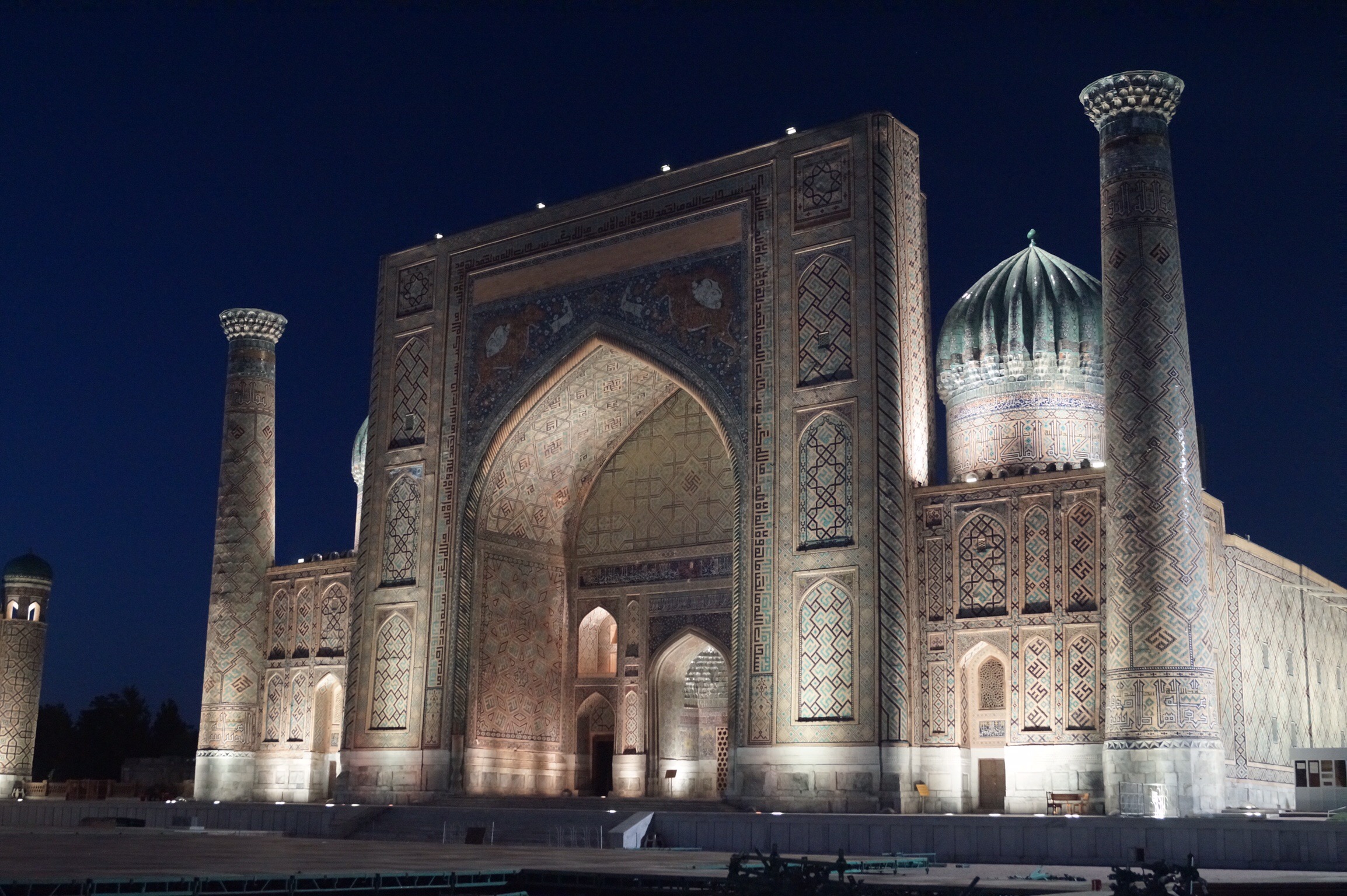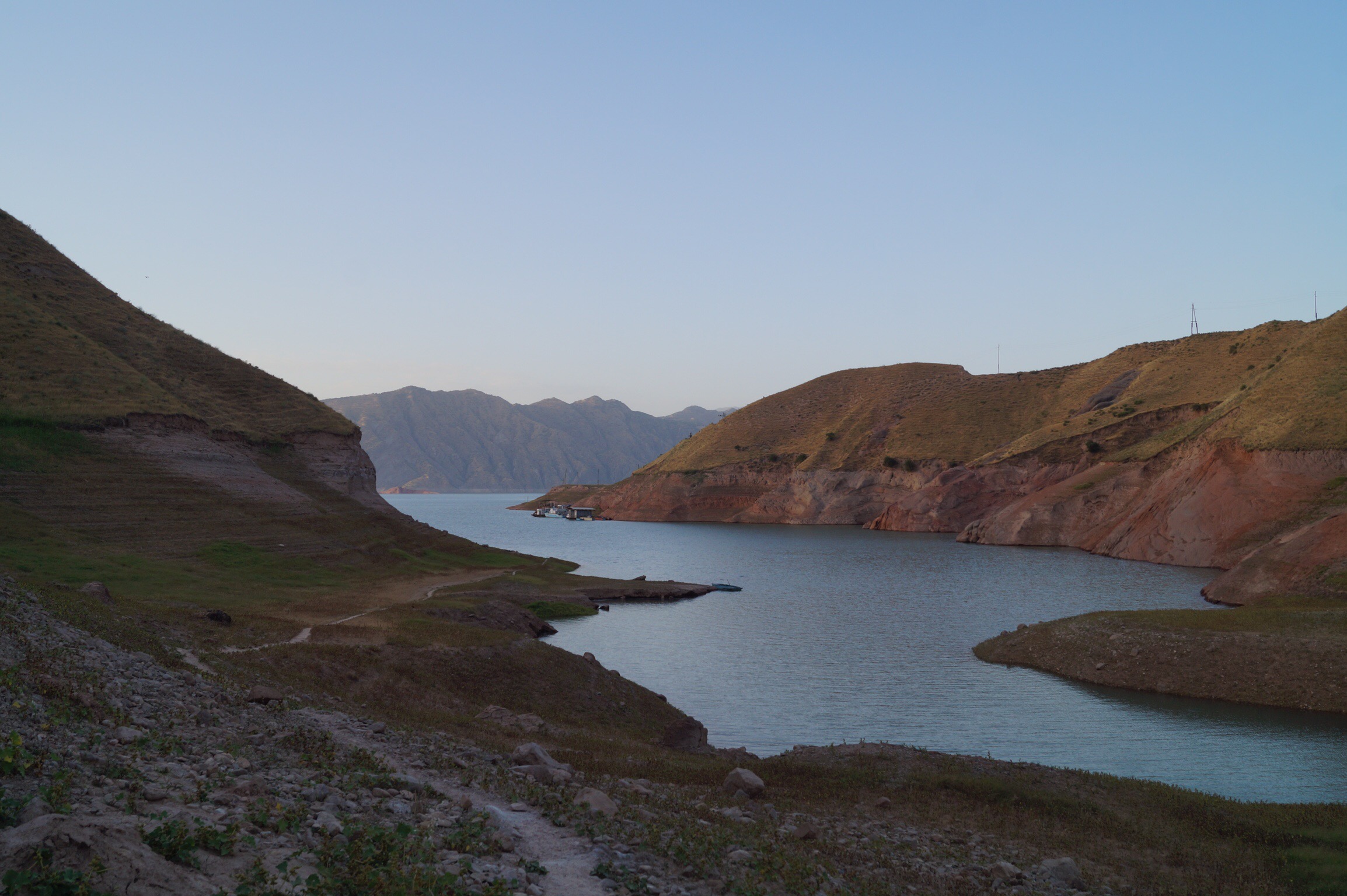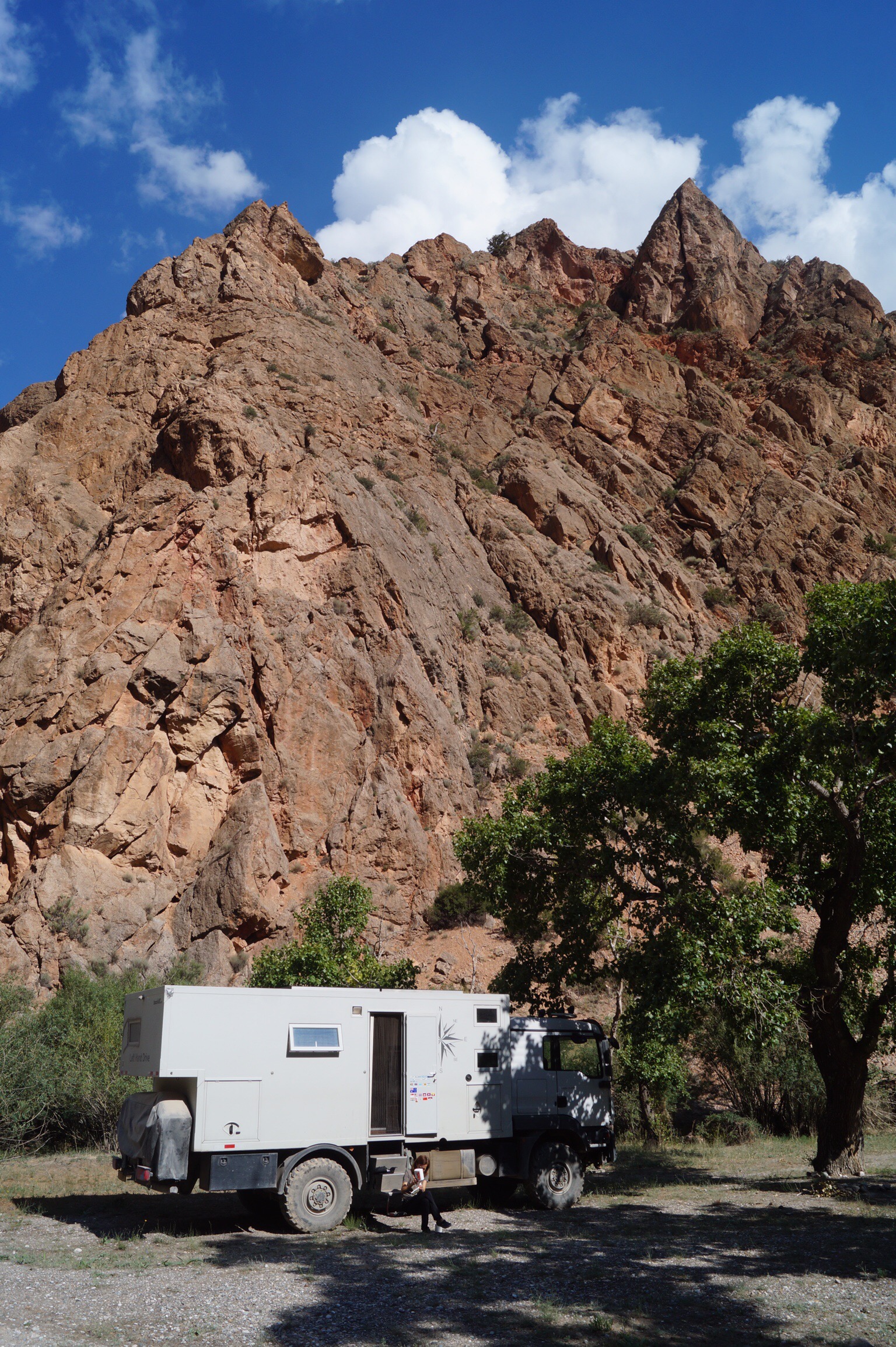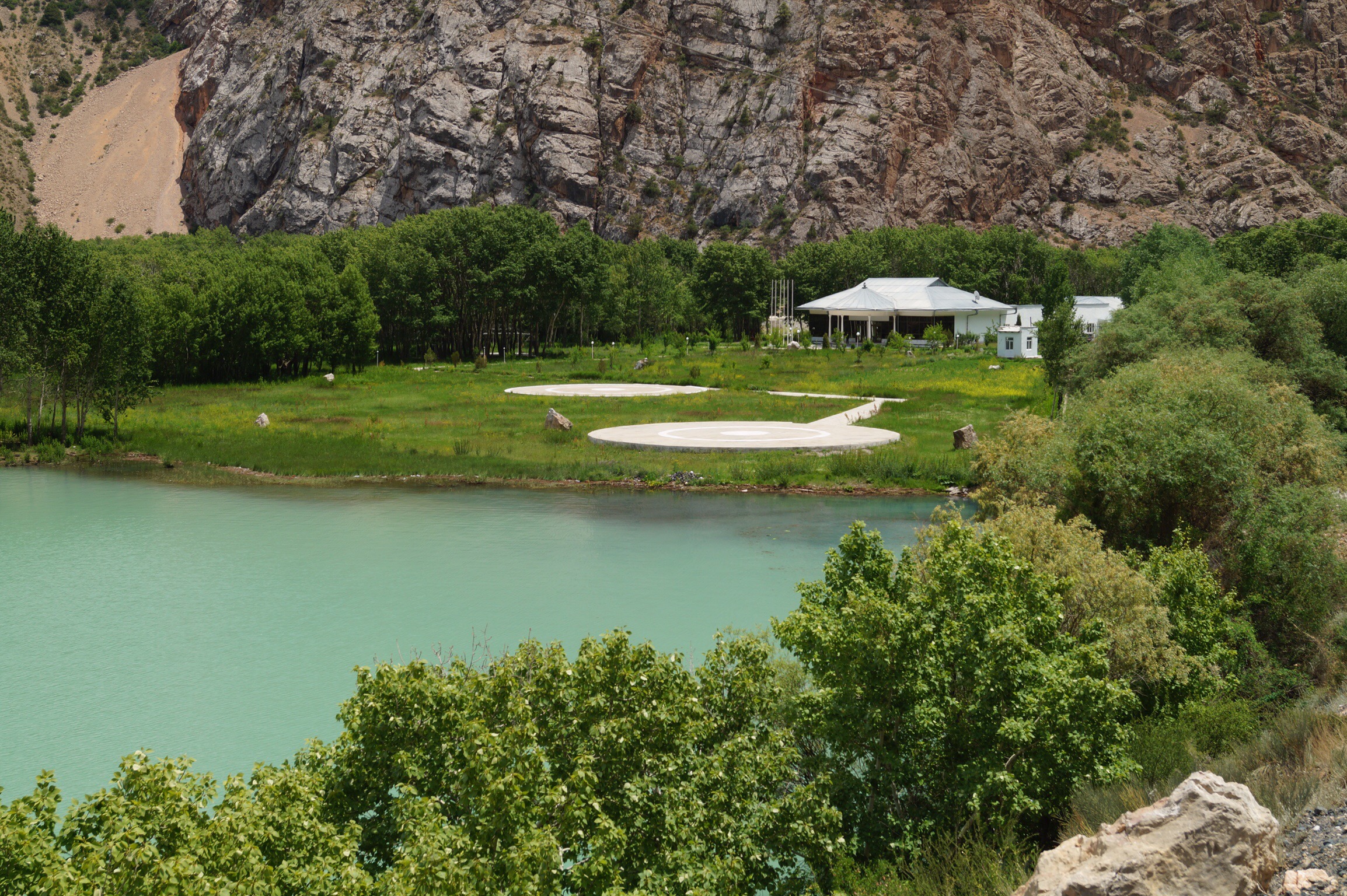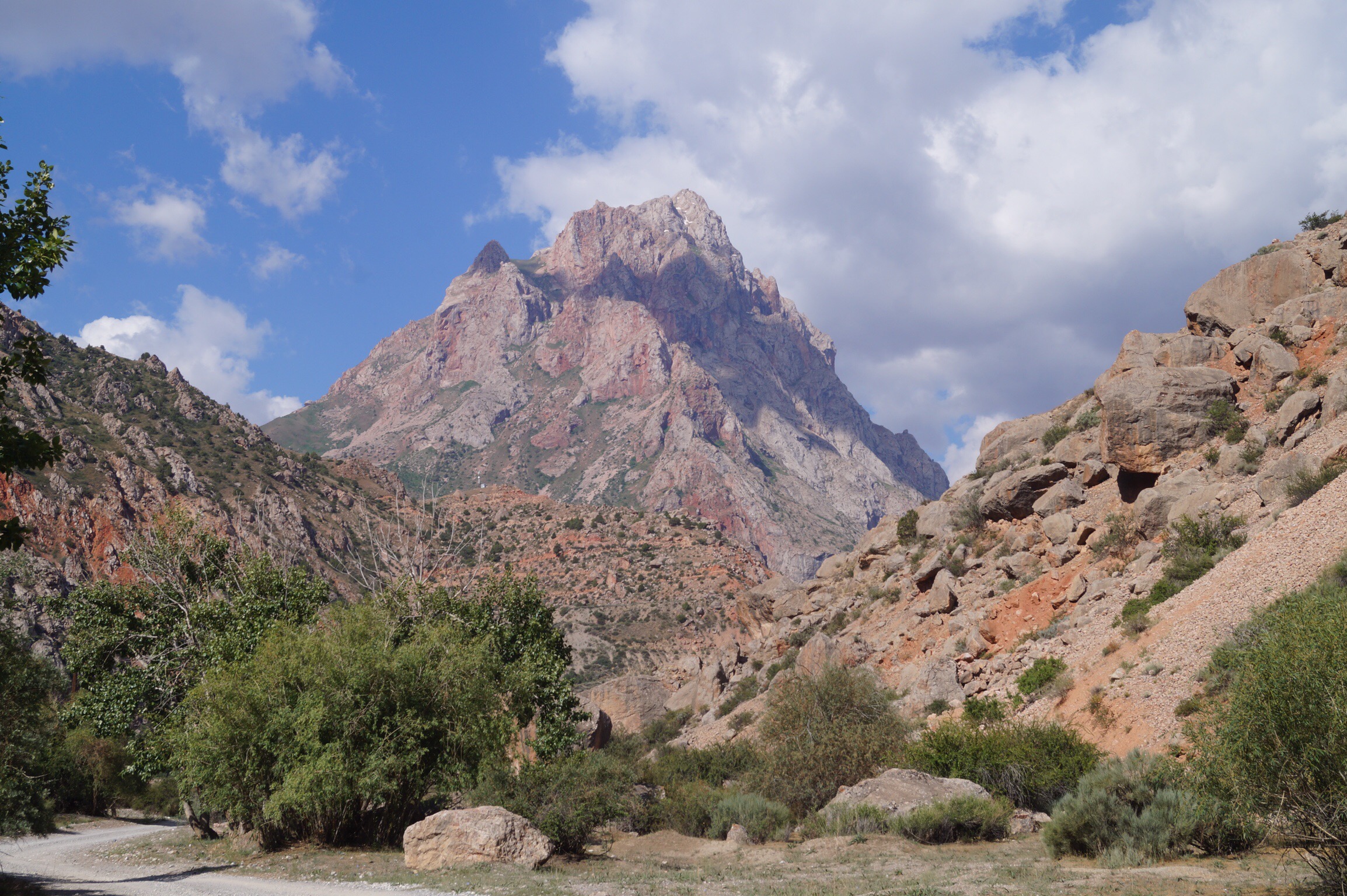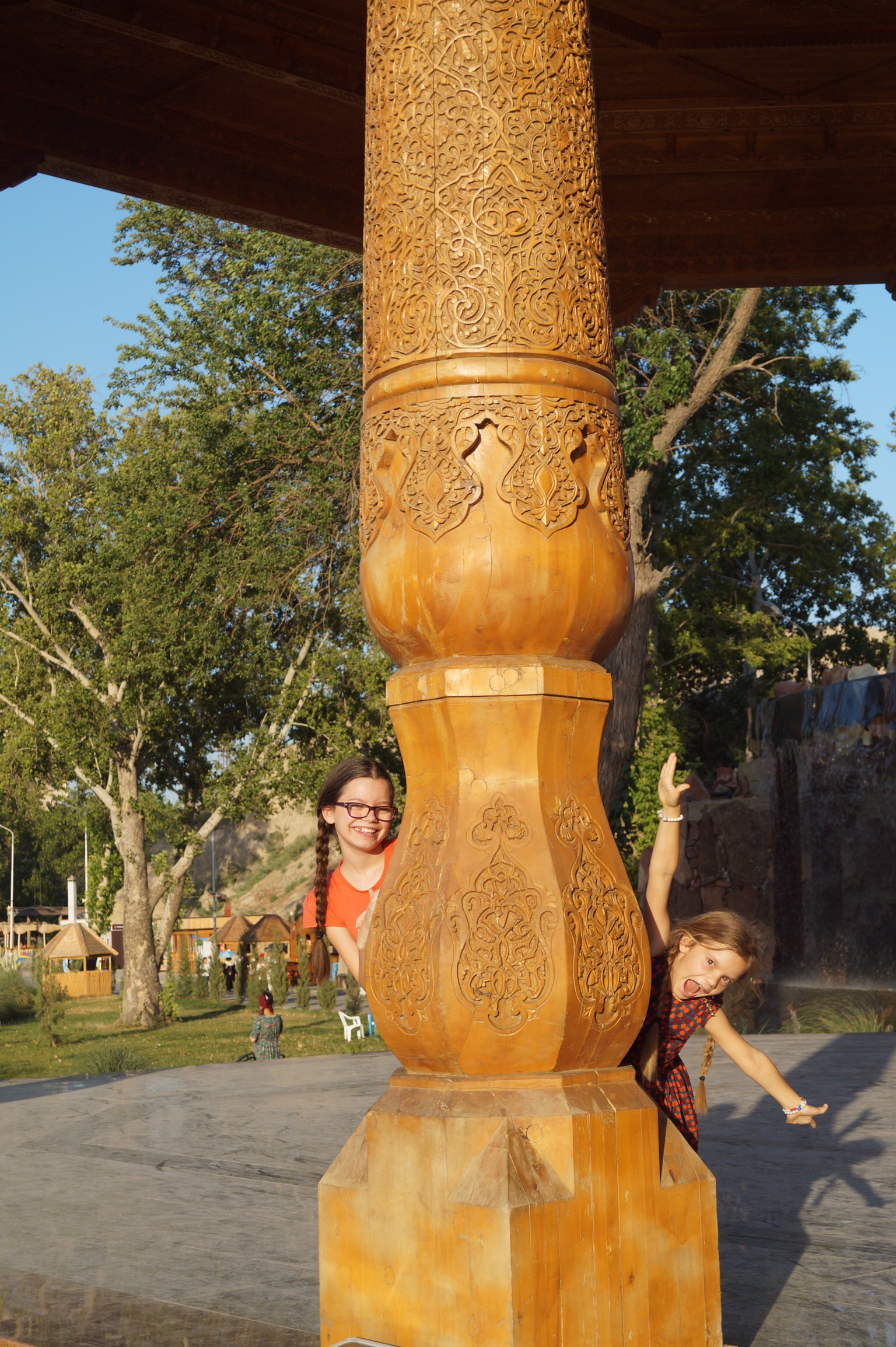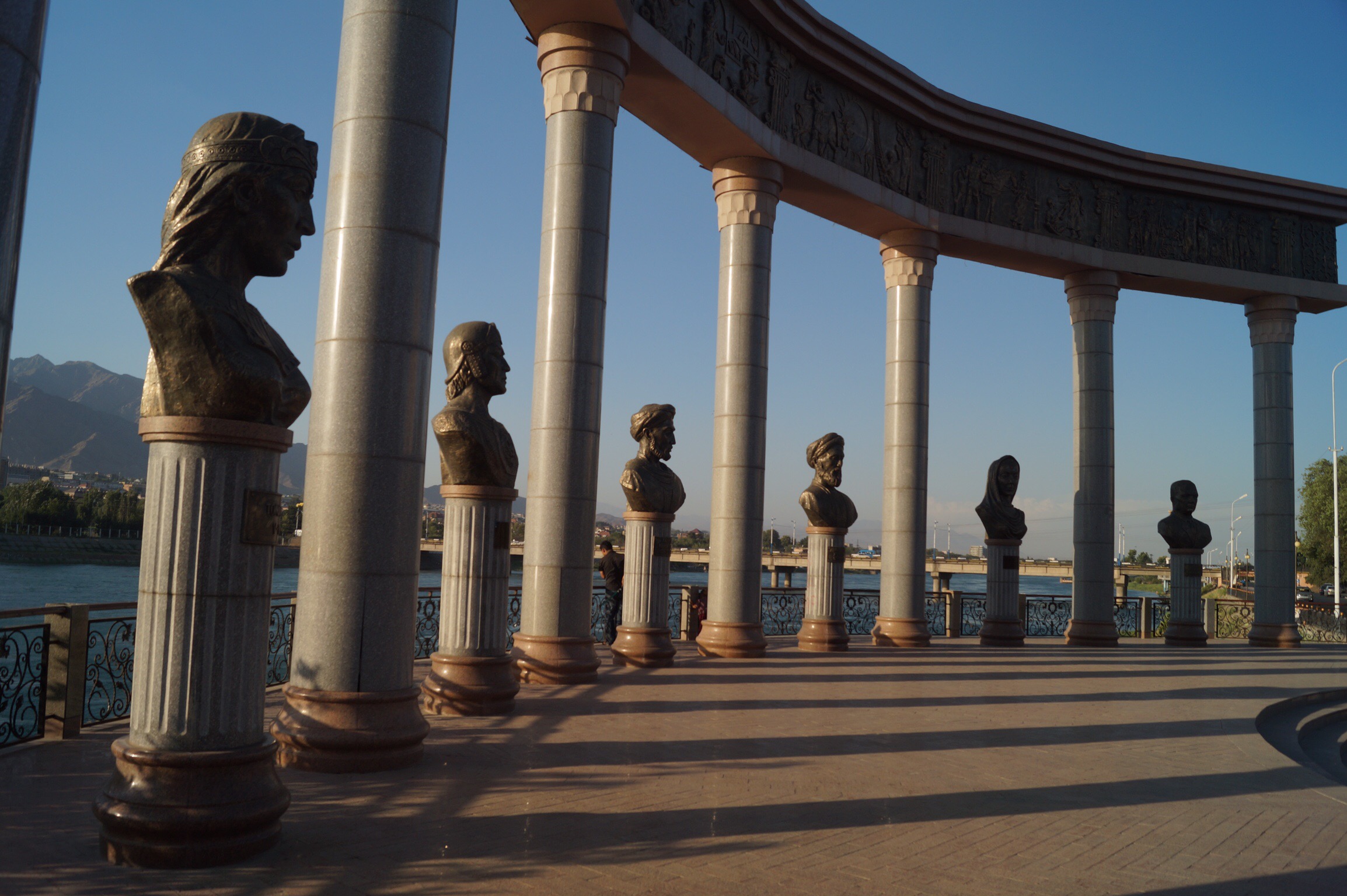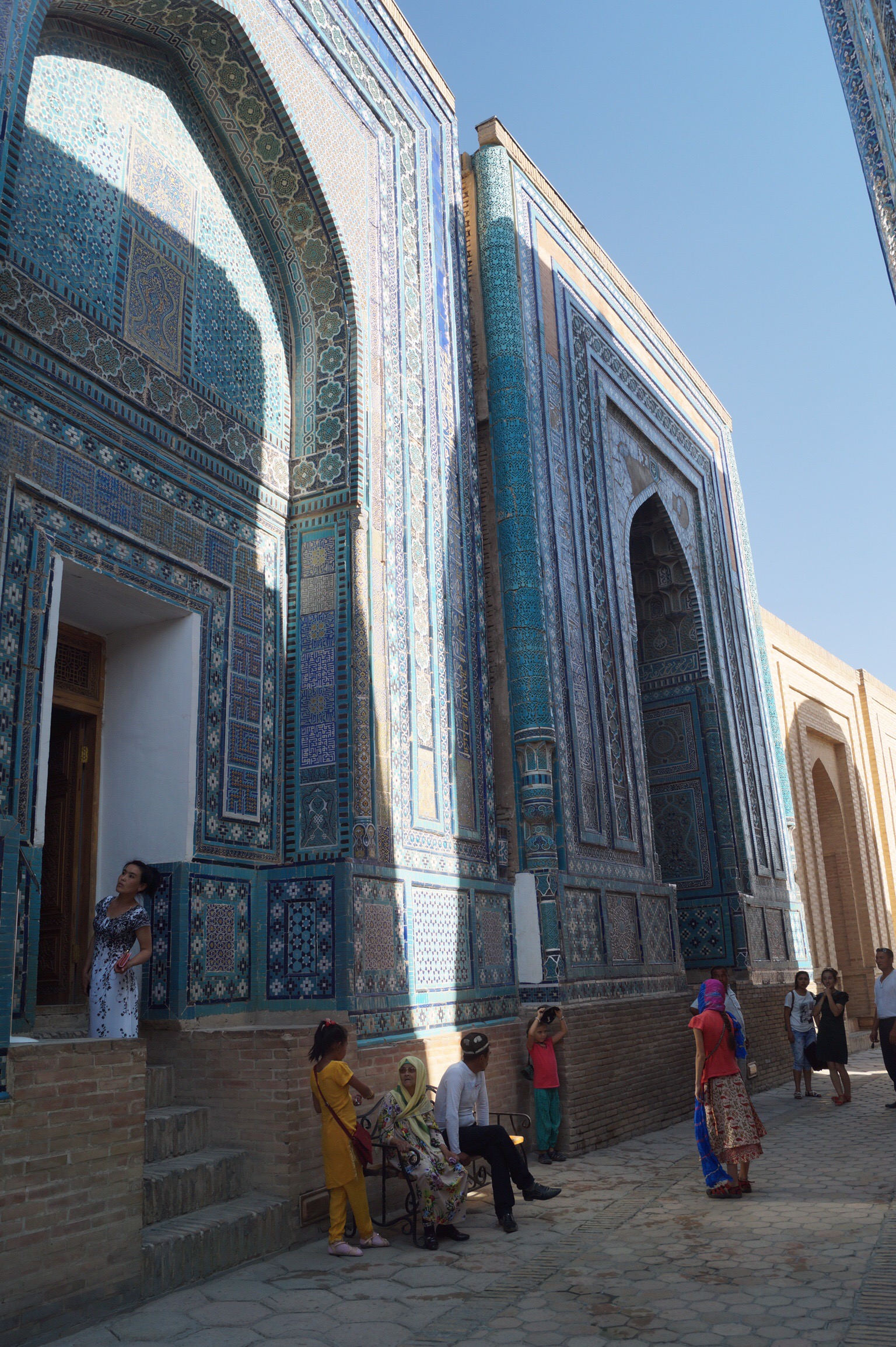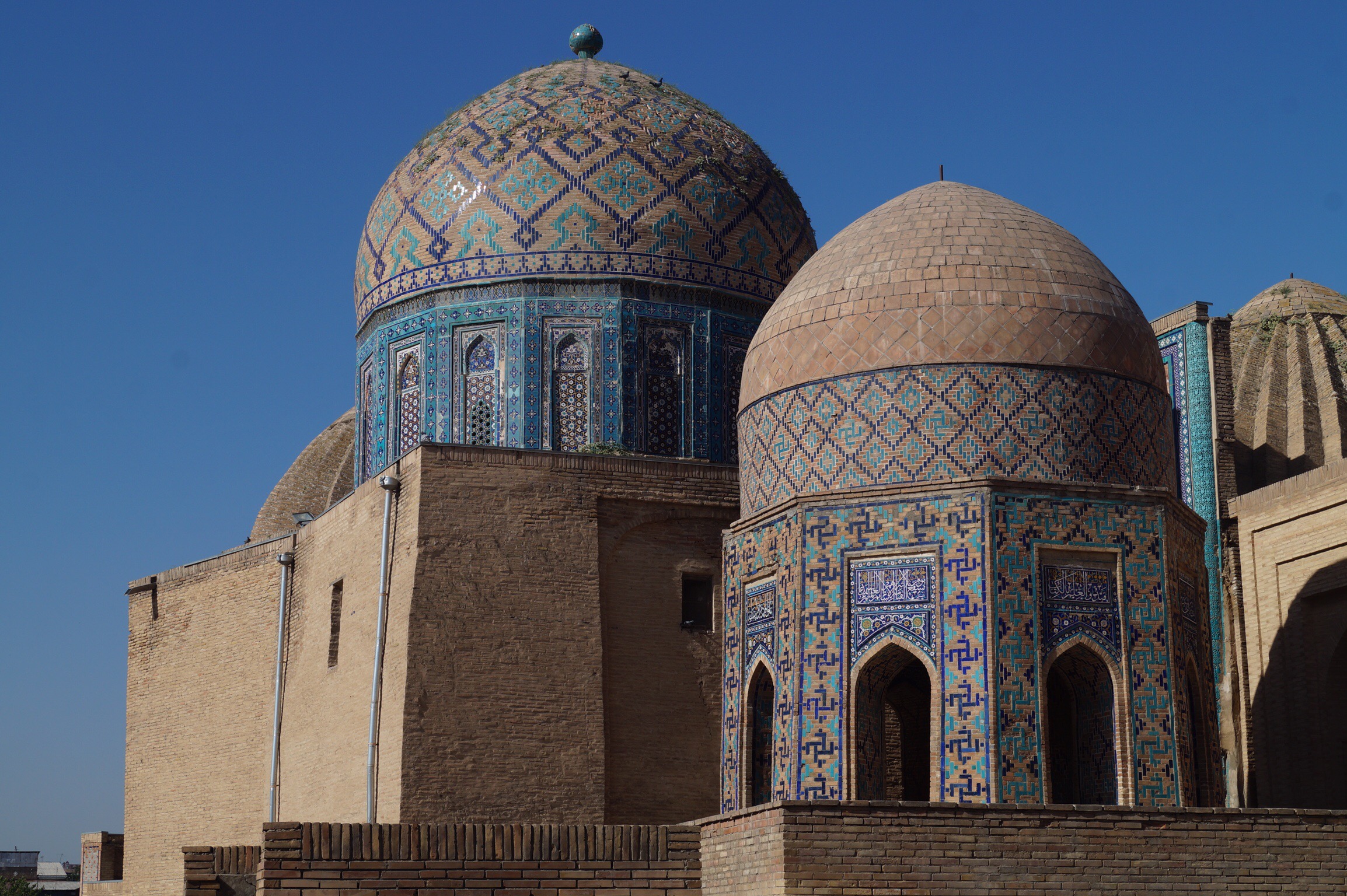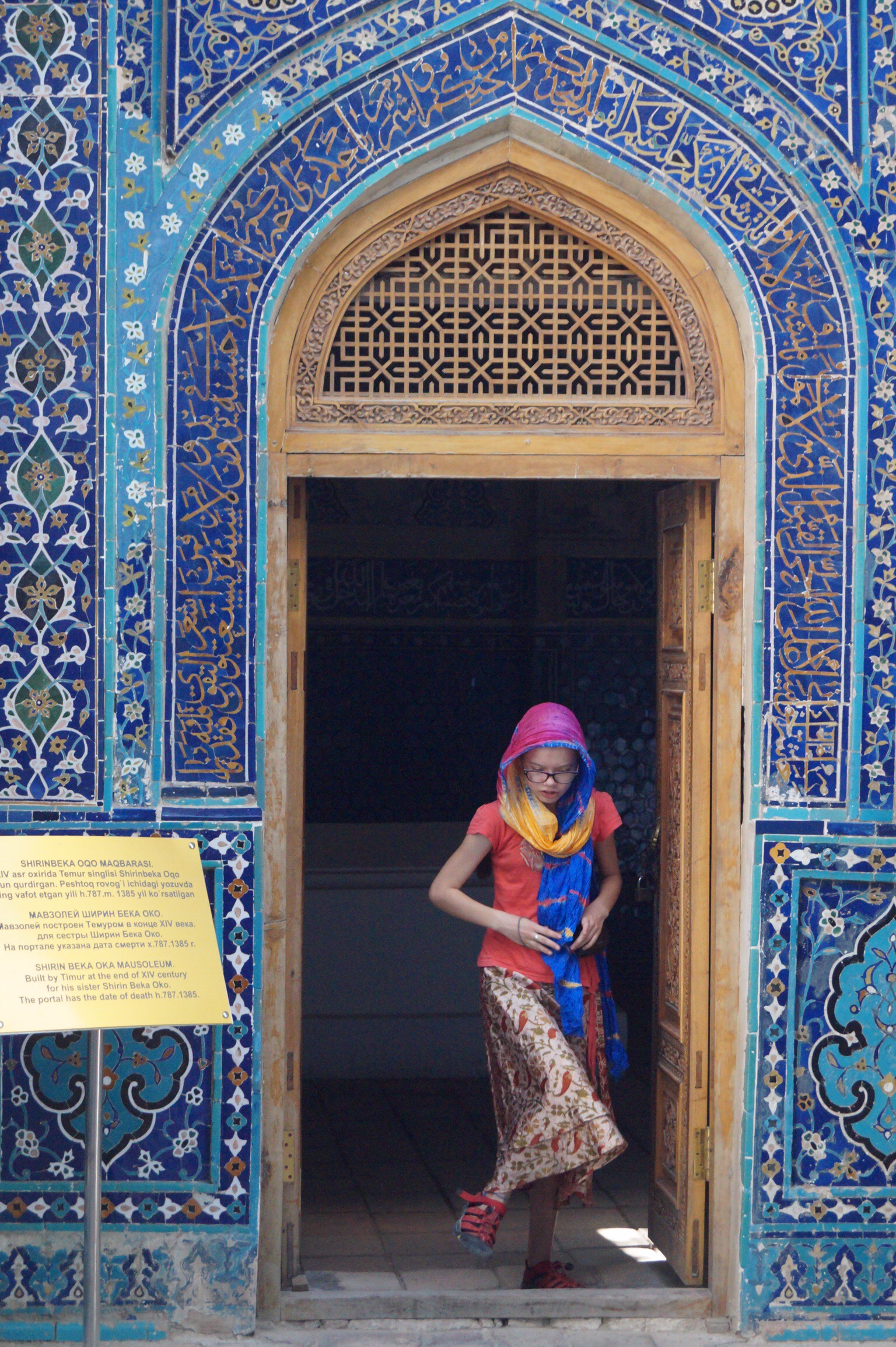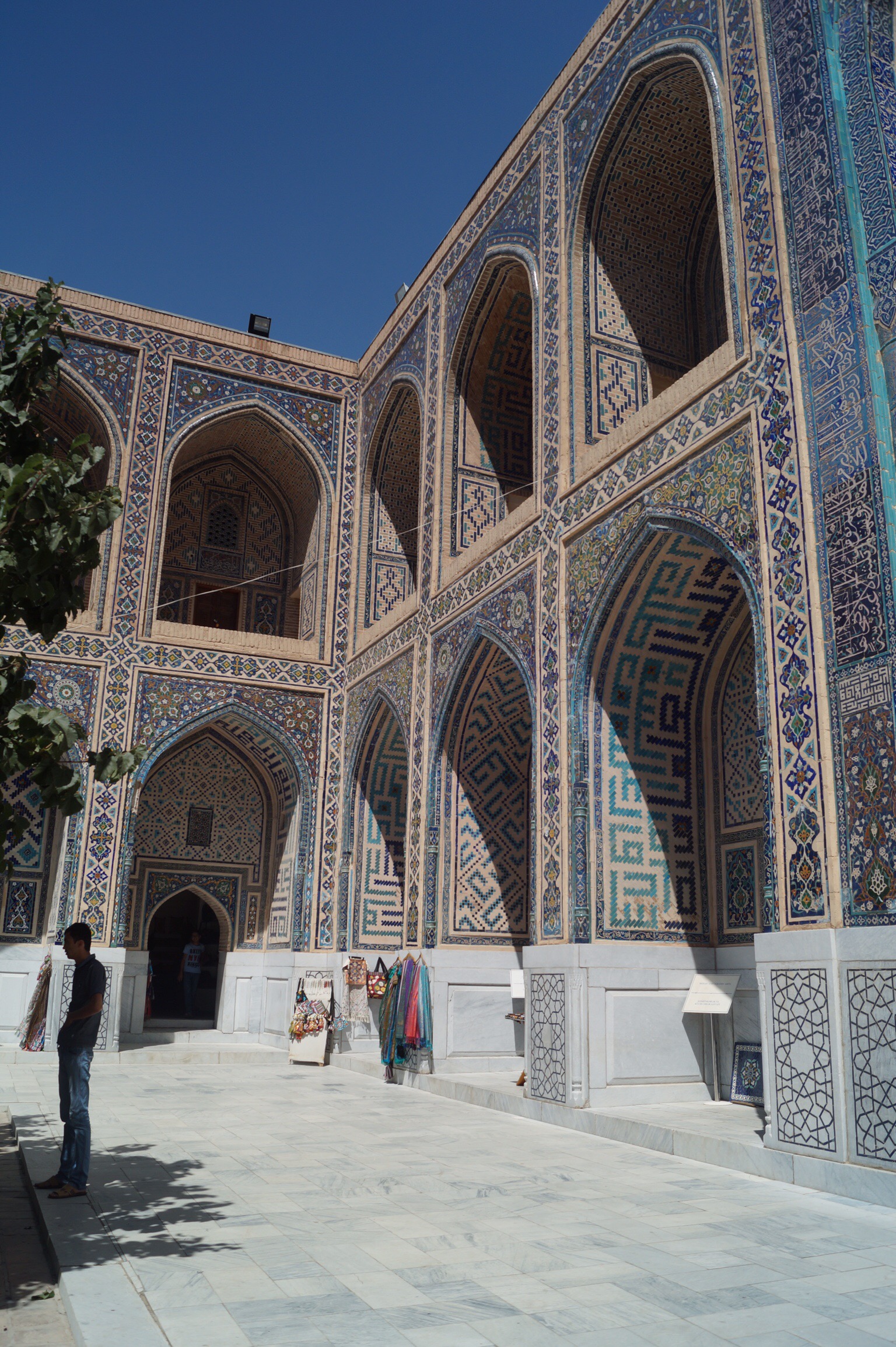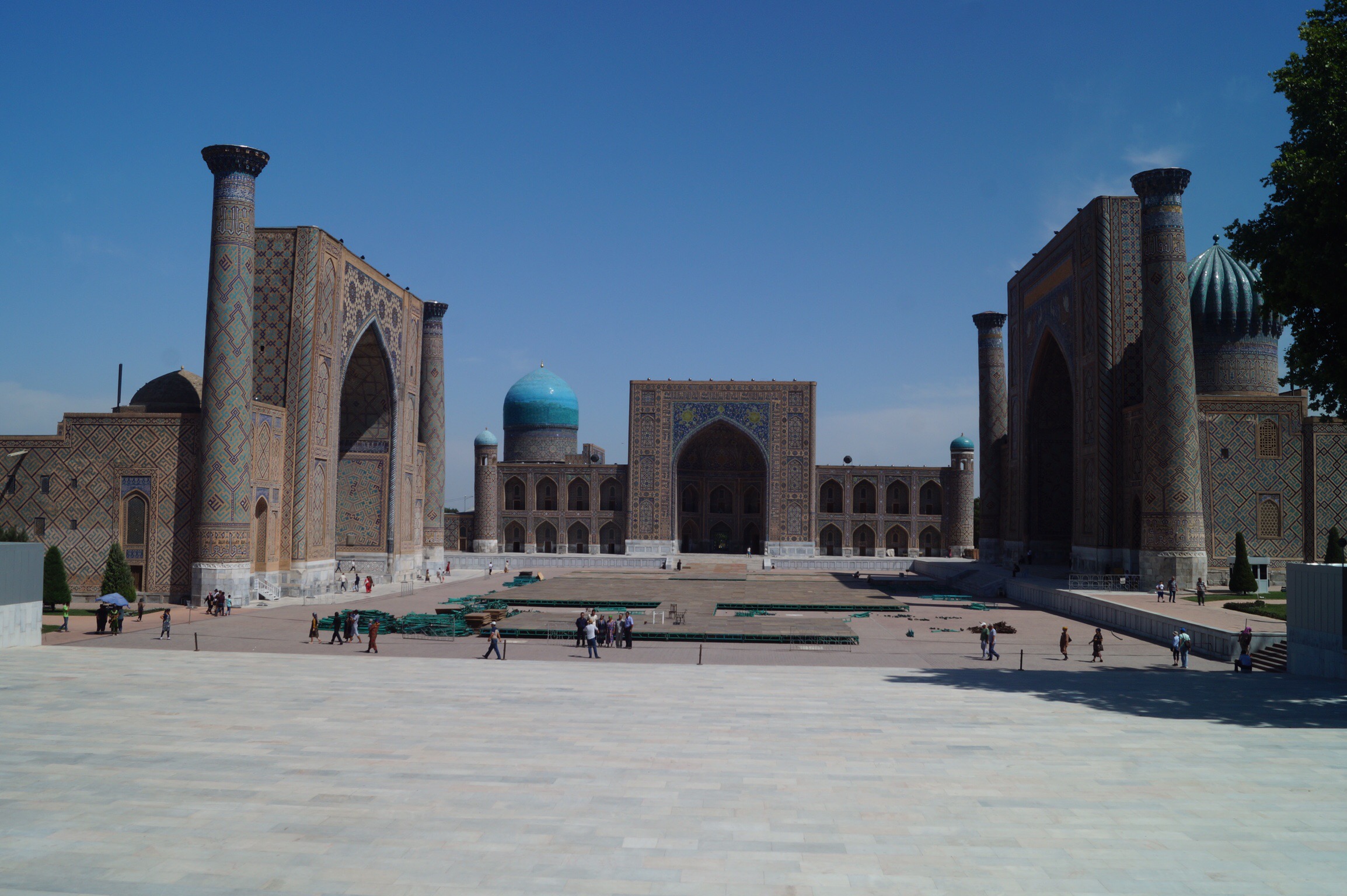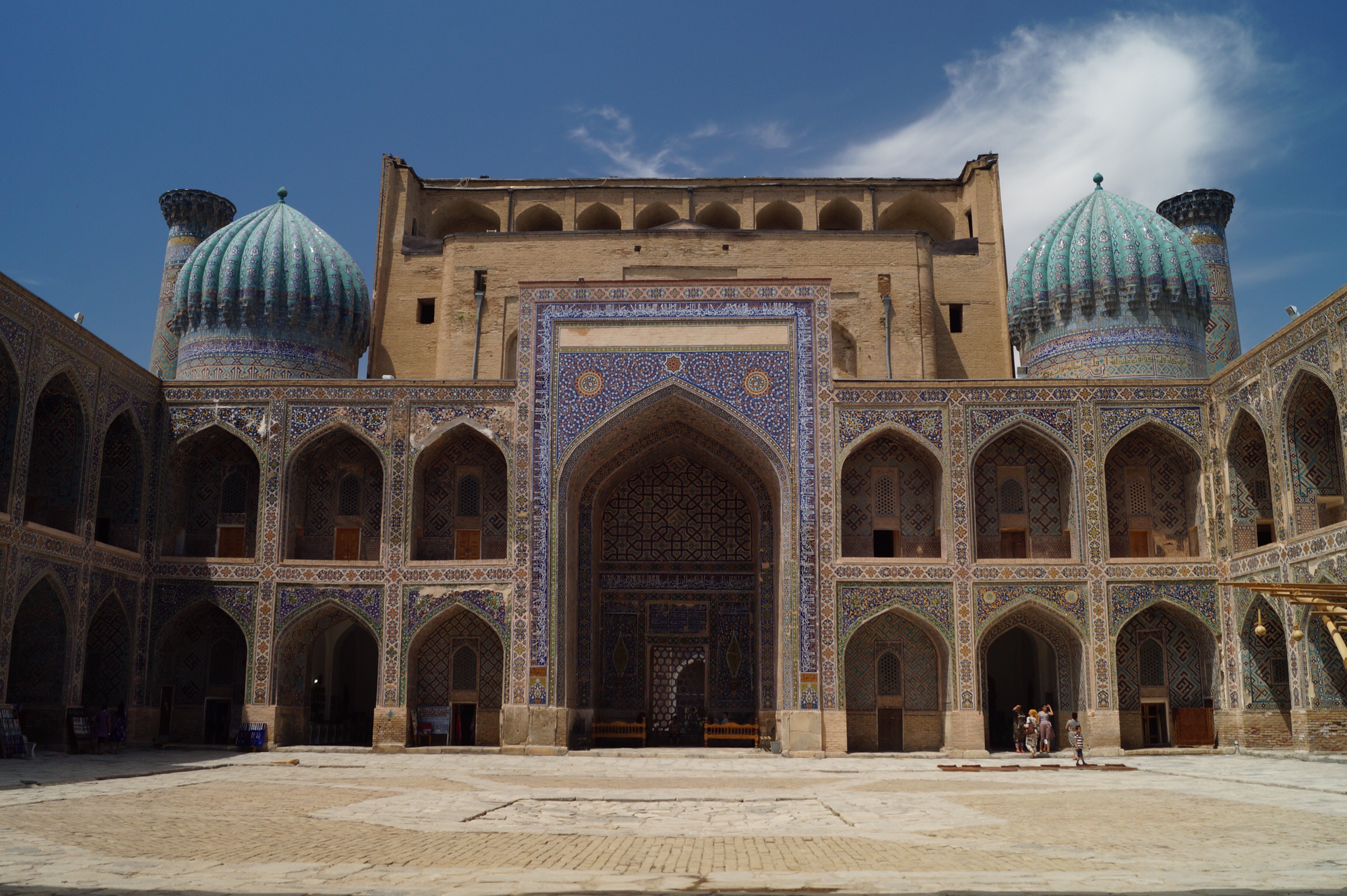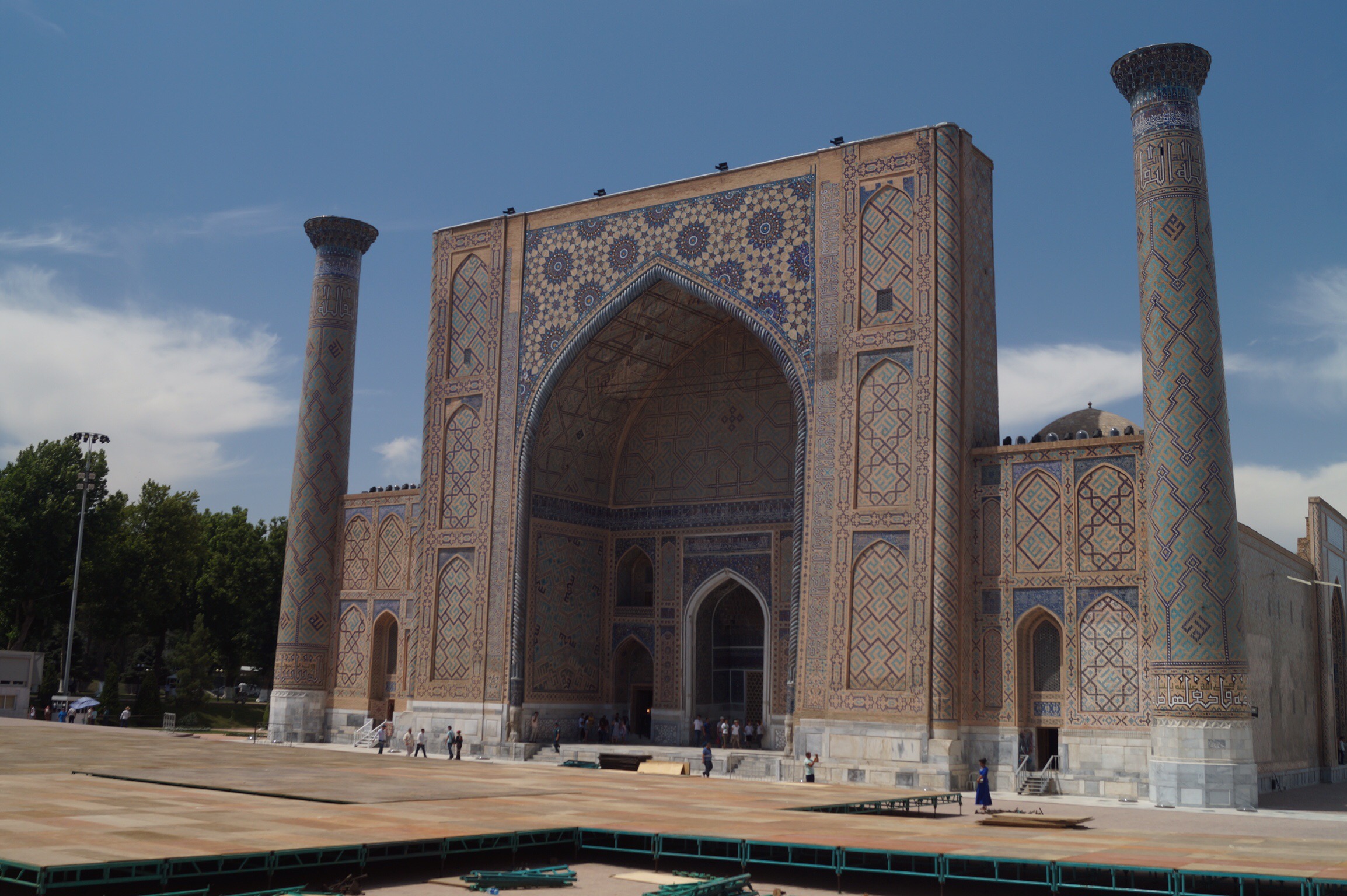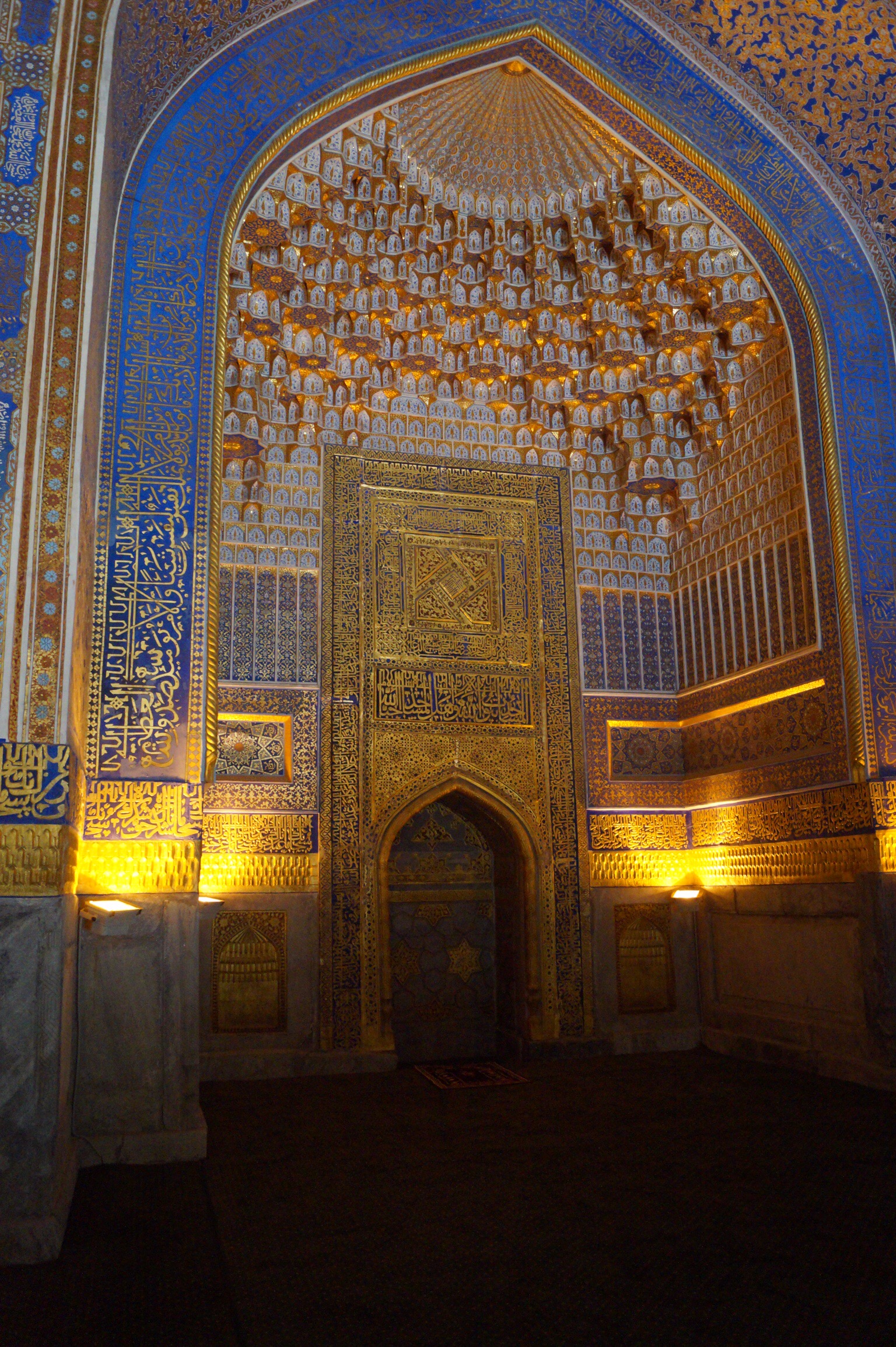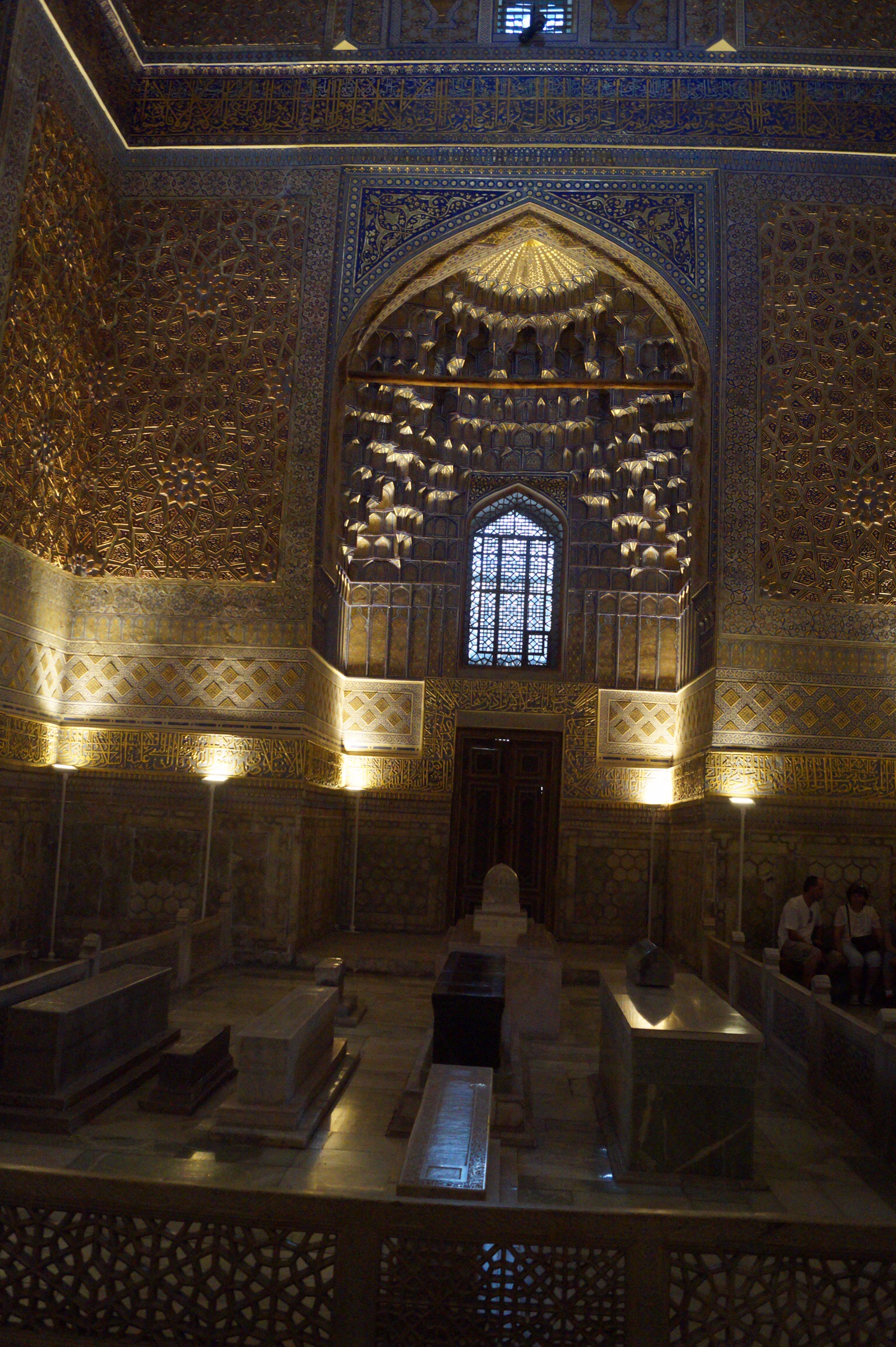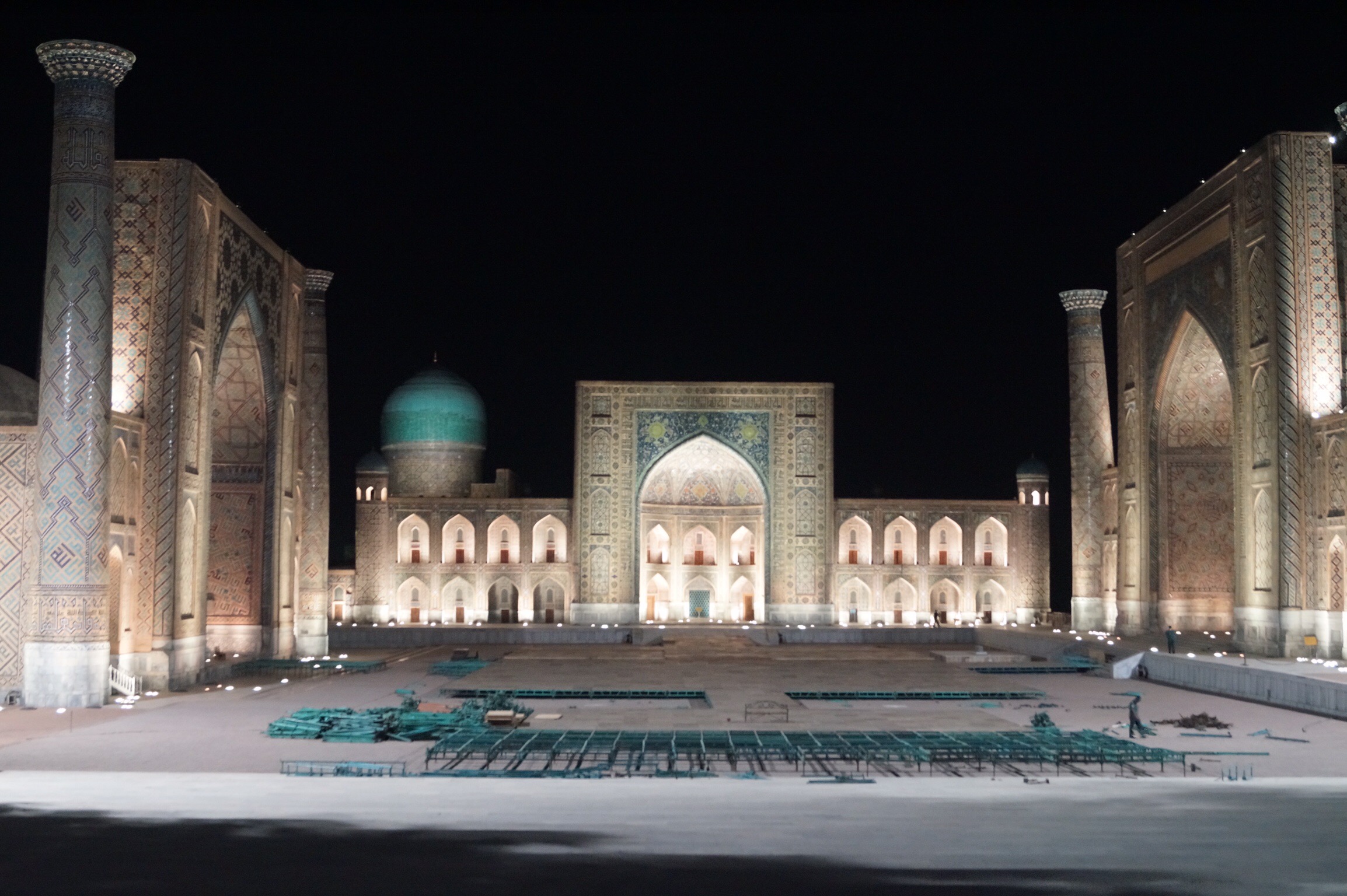This past week we have been literally "a stone's throw" from Afghanistan, to prove it we stopped the truck and tried it out at the river which represented the border between Tajikistan and Afghanistan. Steve got his stone onto the opposite riverbank but the rest of us didn't manage so far. We were just across the Pamir River, running into the Panj River, in Tajikistan. The Wakan Corridor is a narrow strip of Afganistan that was designed to separate British India from Imperial Russia during the "Great Game" era. The road continued along the starkly beautiful valley for another 640km with Afghanistan just across the raging river torrent.
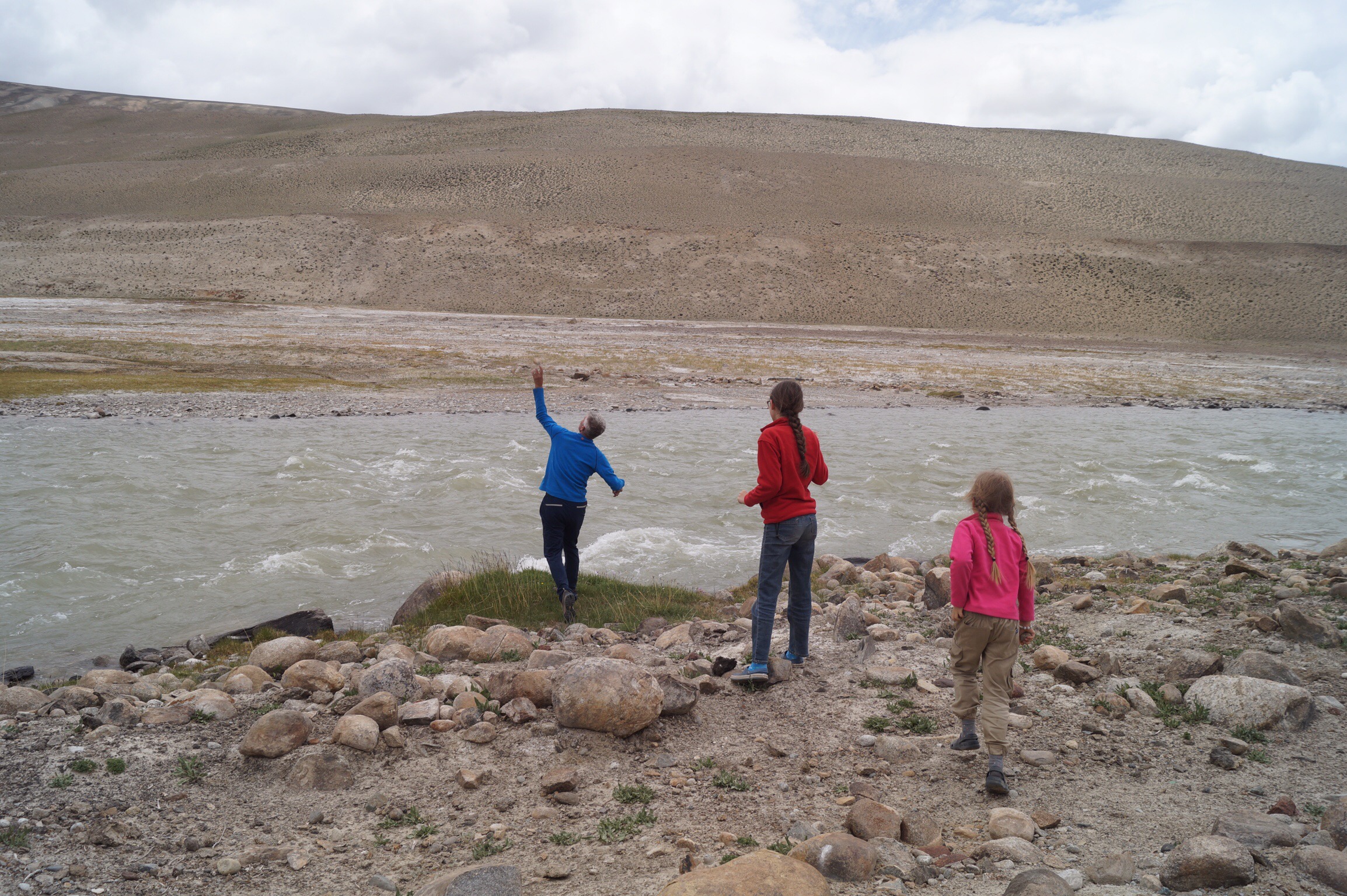
We left Kyrgyzstan earlier in the week at what must be one of the most remote border crossings we have done for a while. The road started off bad and got far worse as we crossed the Kyzyl-Art Pass between the countries. Washed out bridges, mud slides and huge potholes were hard to concentrate on as our eyes were constantly drawn upwards to the lofty peaks still shrouded in snow in the height of summer. We said goodbye to our last mountain sheep statue on a plinth, a frequent roadside attraction in Kyrgyzstan, and gingerly made our way down the other side. With so few people using the border the Tajik soldiers had to be roused from their beds to process the many documents we needed to get into the country. The contrast couldn't have more different, while the Kyrgyz side was green, it felt like we had transited to the moon with the stark lunar landscape on the Tajik side.


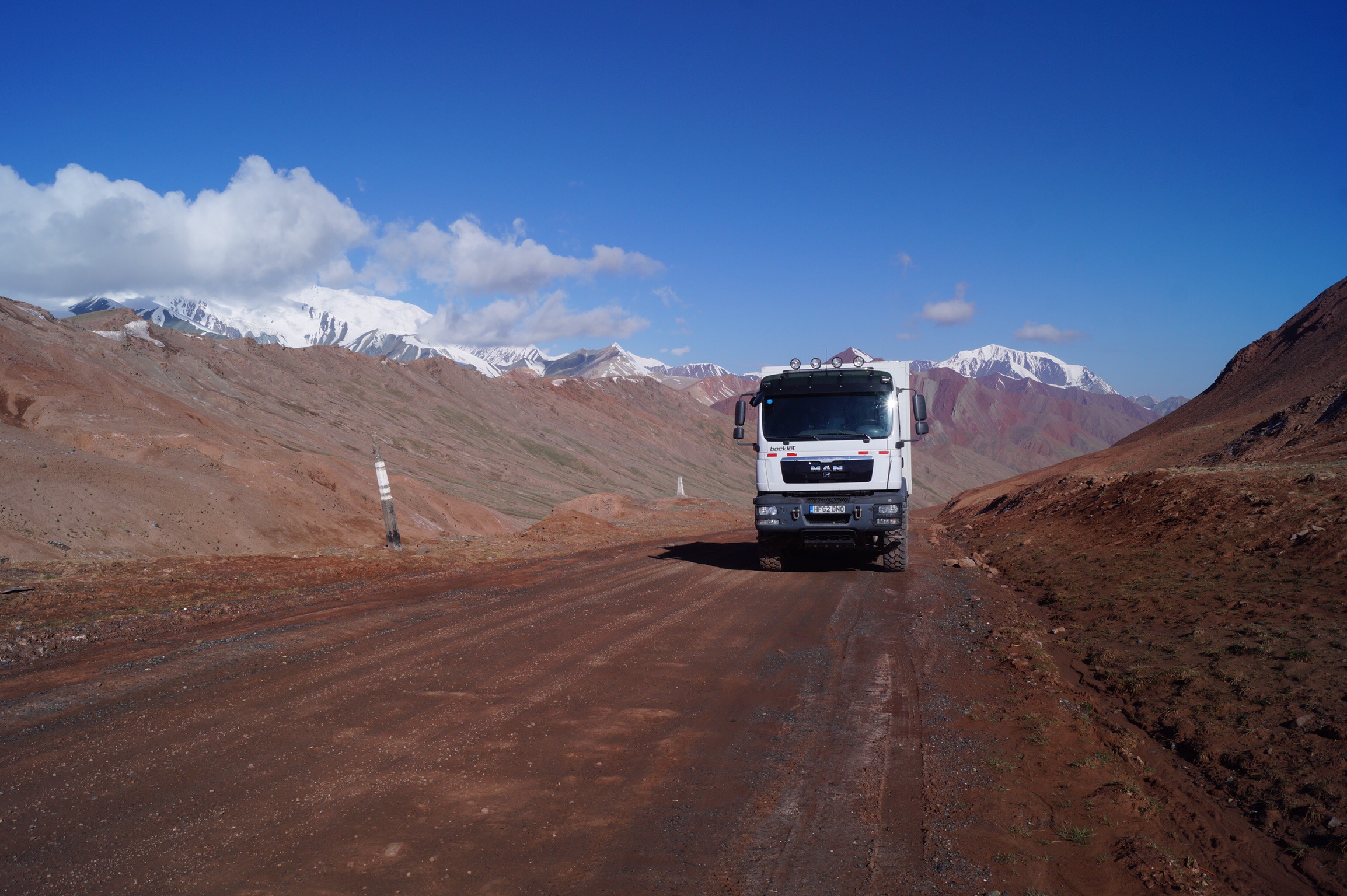
In a panorama with so few people it wasn't hard to find a spot to camp in, however an hour or so after we had set up camp an almost impossible-to-break, soviet built, small UAZ truck approached us. They wanted to cross the river, swollen with melt water, to go to their summer camp but were concerned about getting stuck. Could we pull them out them out if it all went wrong? We were pleased to get back to our chicken stew on the fire, when they made it though. We were even more pleased for them, when washing up, to see them crossing back safely over heavily laden with yak dung patties for fuel waving triumphantly.
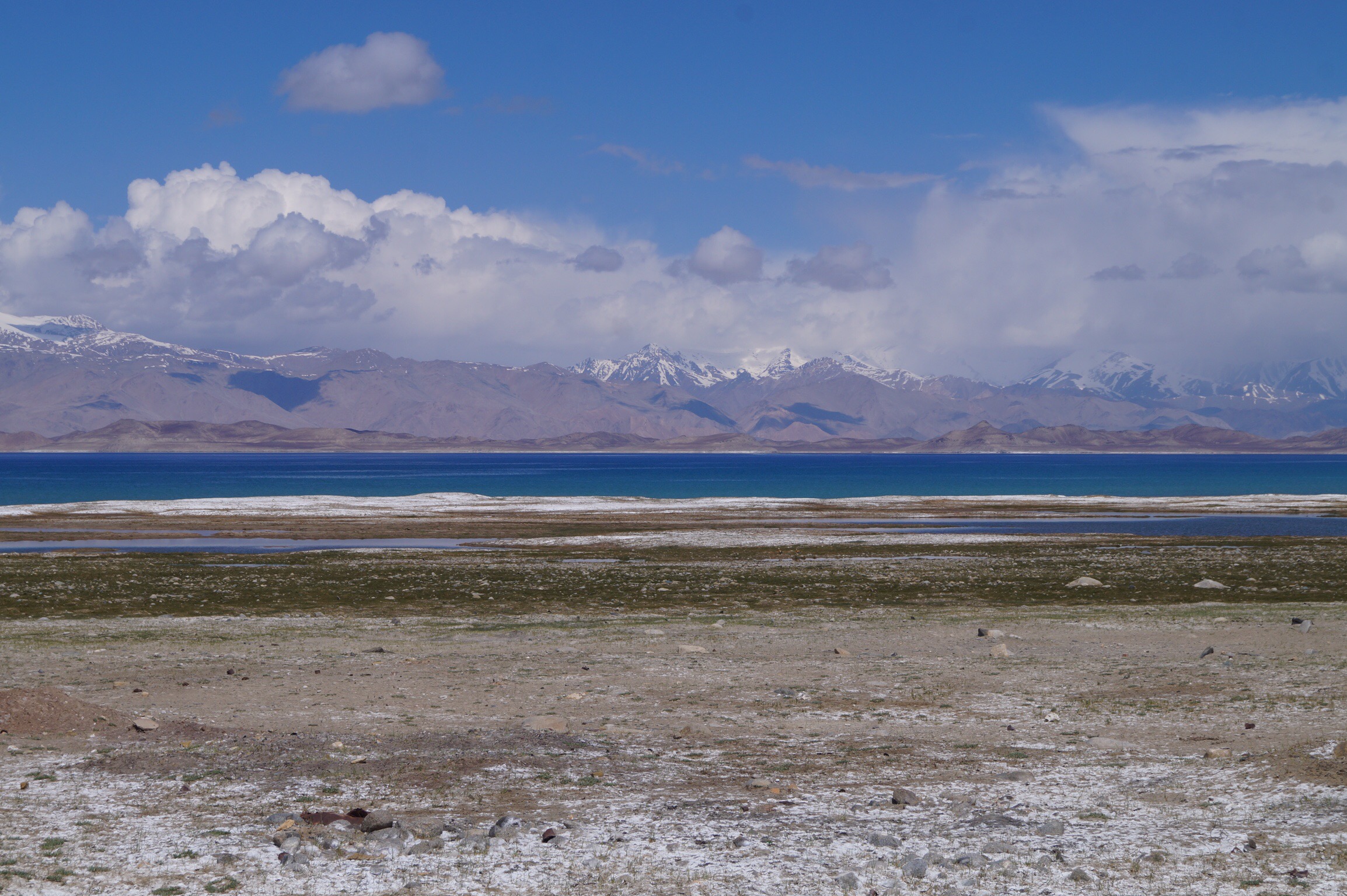


T
he bazaar at Murghab was entirely constructed of old shipping containers, a motley collection in the middle of nowhere but filled with friendly souls many wearing the traditional Kygryz felt hats. The scenery as we drove through the valleys of the Pamir Mountains was otherworldly with screes slopes of every colour of the rainbow, I hadn't even know that you could get purple rocks. Above these were the constant presence of high peaks cloaked in white. That night we took a detour a few kilometres off the road to sleep the night beside Lake Bulunkul. When we awoke in the morning, Steve and I snuck out while the girls slept on to climb the nearby hill and admire the still, mirror-like lake reflecting the surrounding mountains.


Although the main road continued through Pamirs, we wanted to take a side route across the Kargush Pass towards the Tajik border overlooking the Wakan Corridor of Afganistan. It was a dramatic drive with just the odd marmot as company. We were hoping our special permit was valid at the rough two man army checkpoint on the other side, there had been some confusion at an earlier checkpoint with our half-forgotten Russian about whether we would be allowed onwards, we didn't fancy the drive back over the pass. We were allowed to continue on the single lane dirt road which was often cut out of the sheer cliffs walls of the valley. Between the army post and the first village of Langar, there was a 70km section that was completely uninhabited.
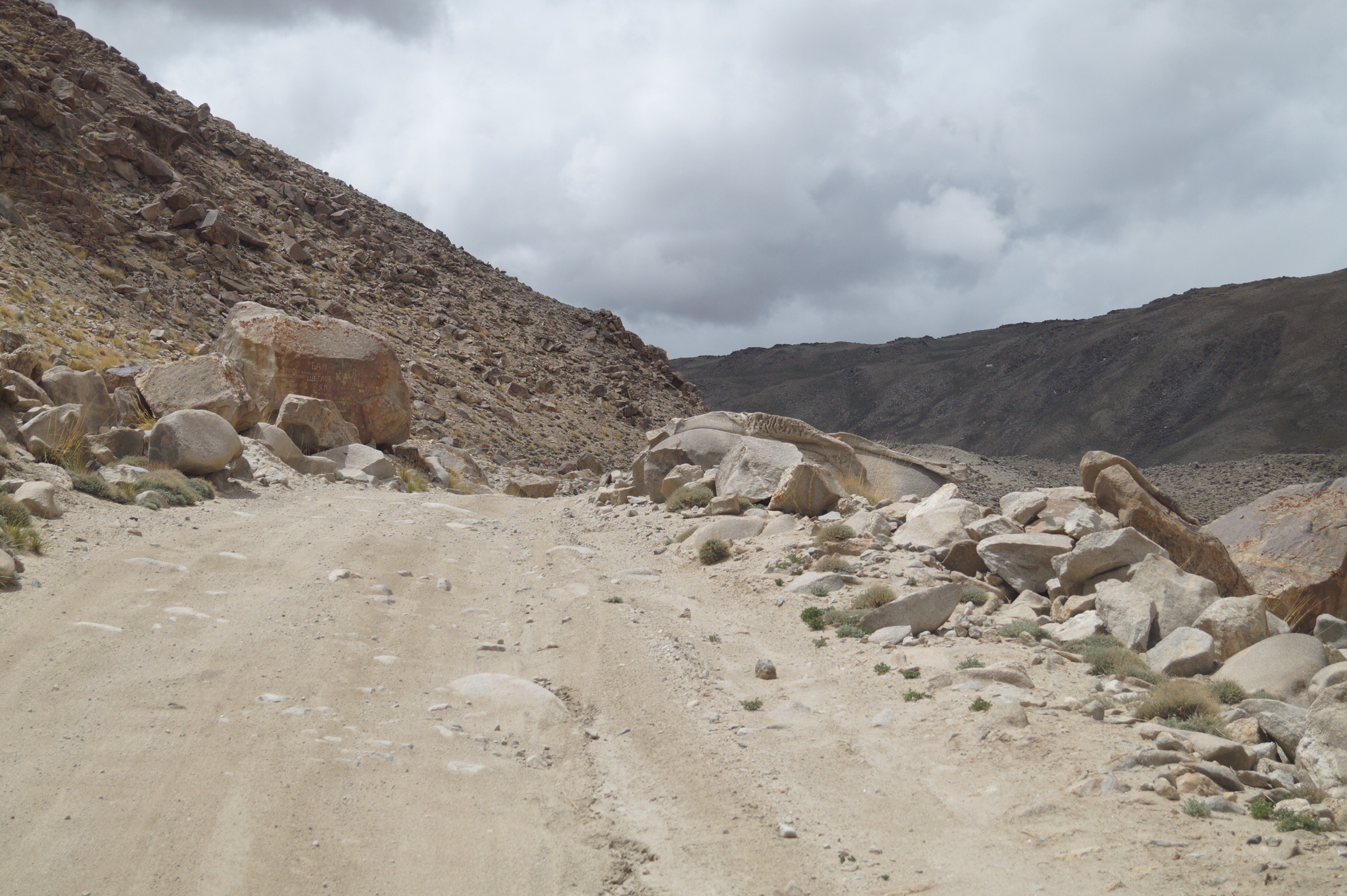

You know you have found a good camp spot when you stop for lunch somewhere and decide to spend the night. With no wind and bathed in sunshine, it was warm enough to sit outside and admire the stark walls of the canyon changing colour as the light shifted. Pulled off on an old section of the road, far above the rushing waters, we saw one other vehicle that whole afternoon. In the mountains the weather is always changeable and after a couple of hours we were snuggled inside listening to the wind howling.
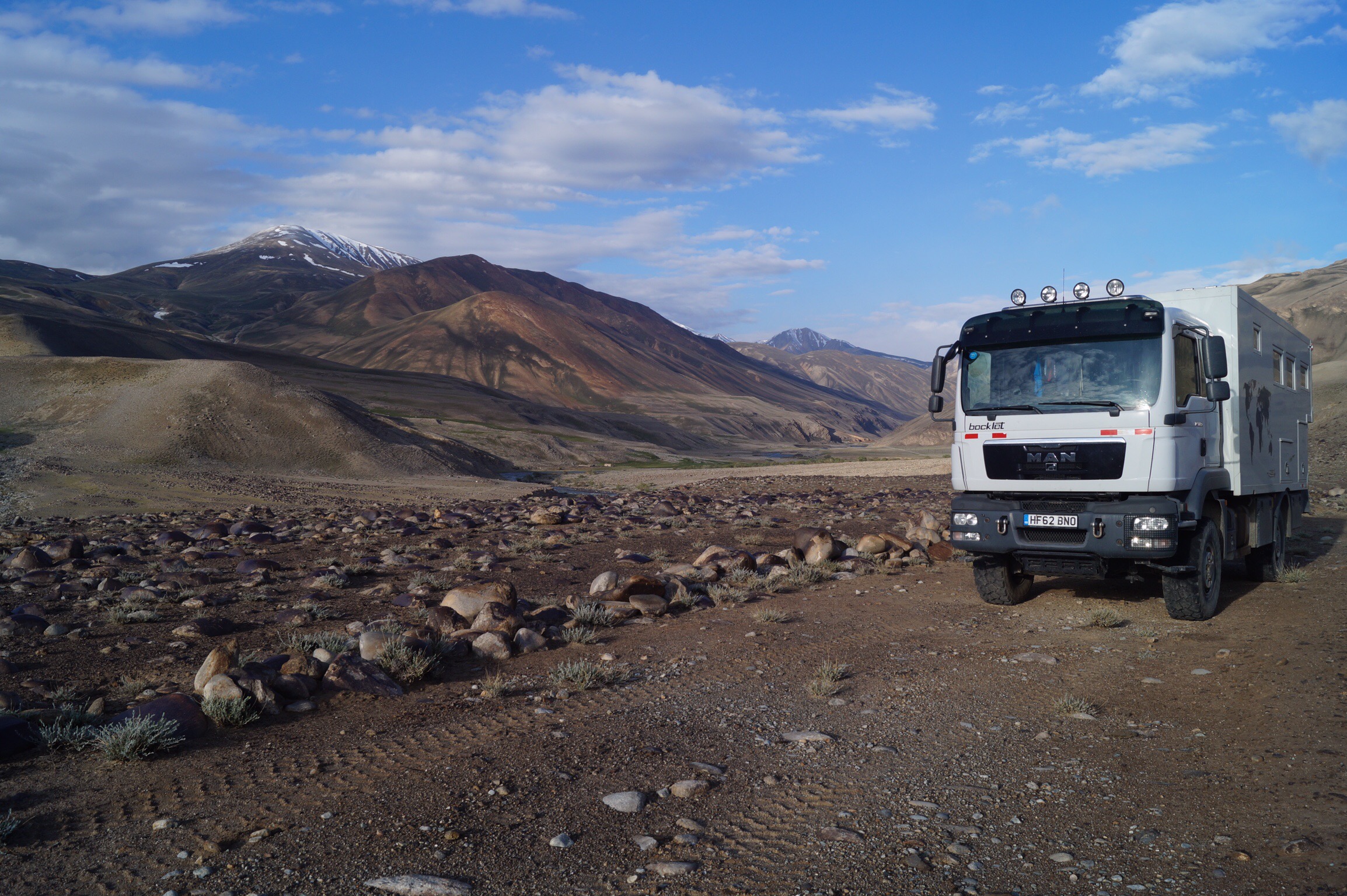
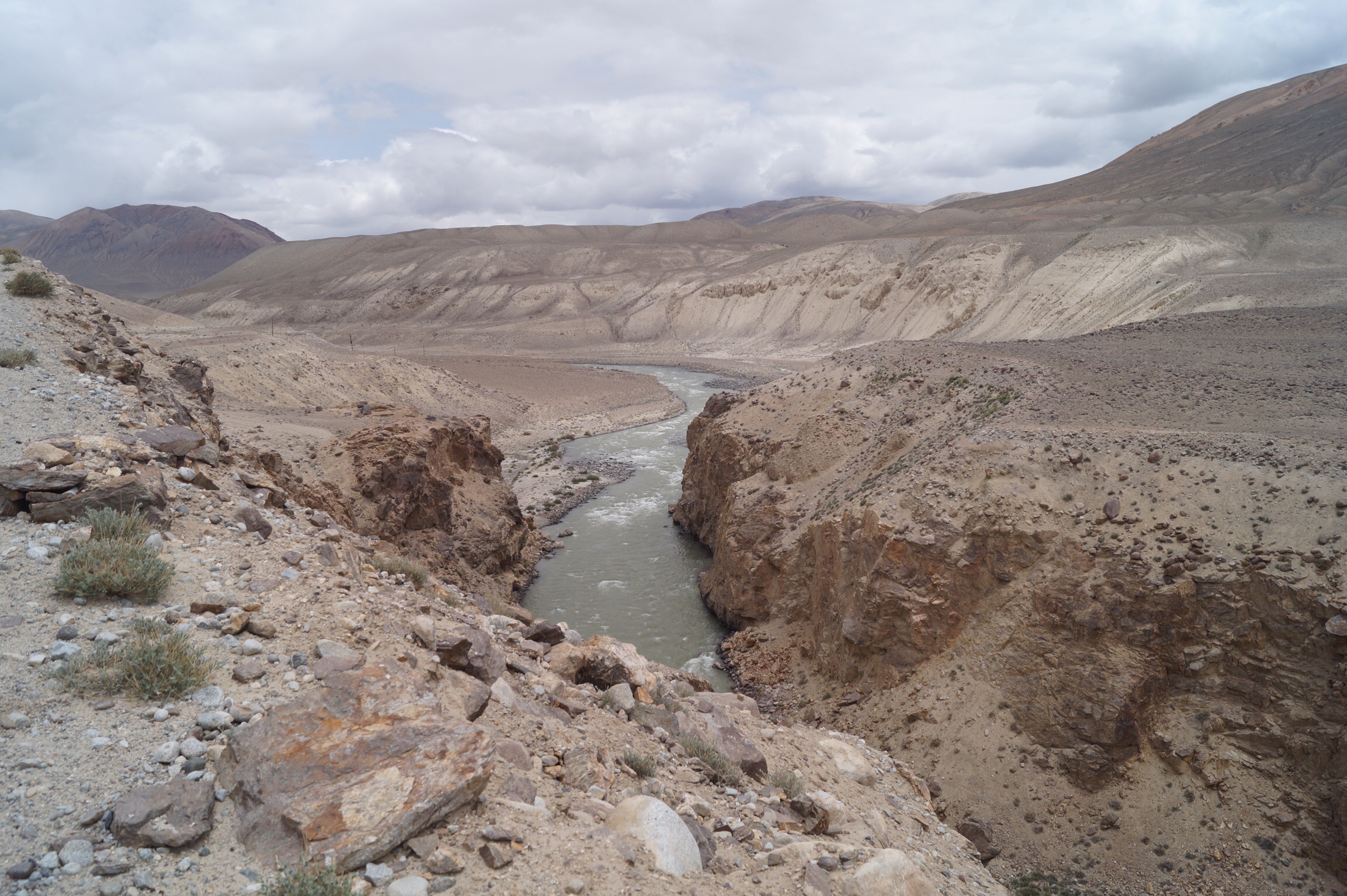
The glimpses we got of Afghanistan, so tantalisingly close, were fascinating. Like the Tajik side, the villages were limited to patches of green clinging perilously to the impossible steep mountainsides. We'd been delighted to learn from the Kygyz herders we met that they use the word "caravan" for a group travelling together. Now here on the Afghan side we saw a caravan, just as how you would imagine it from the Silk Road days, with camels and horses laden with goods packing up at mud brick house. The road was pretty bad on the Tajik side, damaged by spring floods and geological activity, but at least it was continuous. On the Afghani side between a few small hamlets it was still being built, a few men chipping away at the sheer rock face with basic picks, and I assume some dynamite, but thankfully not when we were driving past. Compared with the mental image you get when you think of Afghanistan, it looked very serene and arcadian.
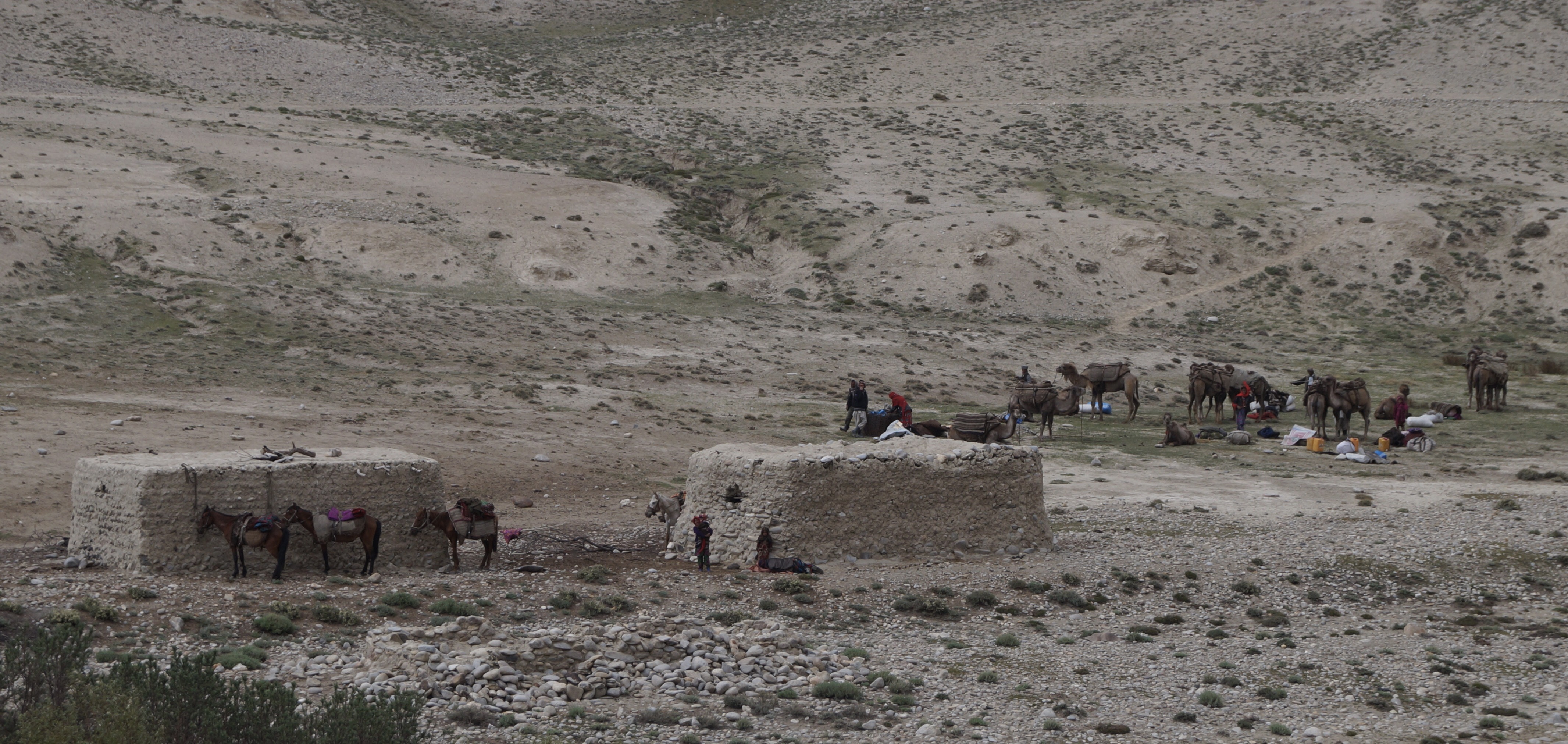
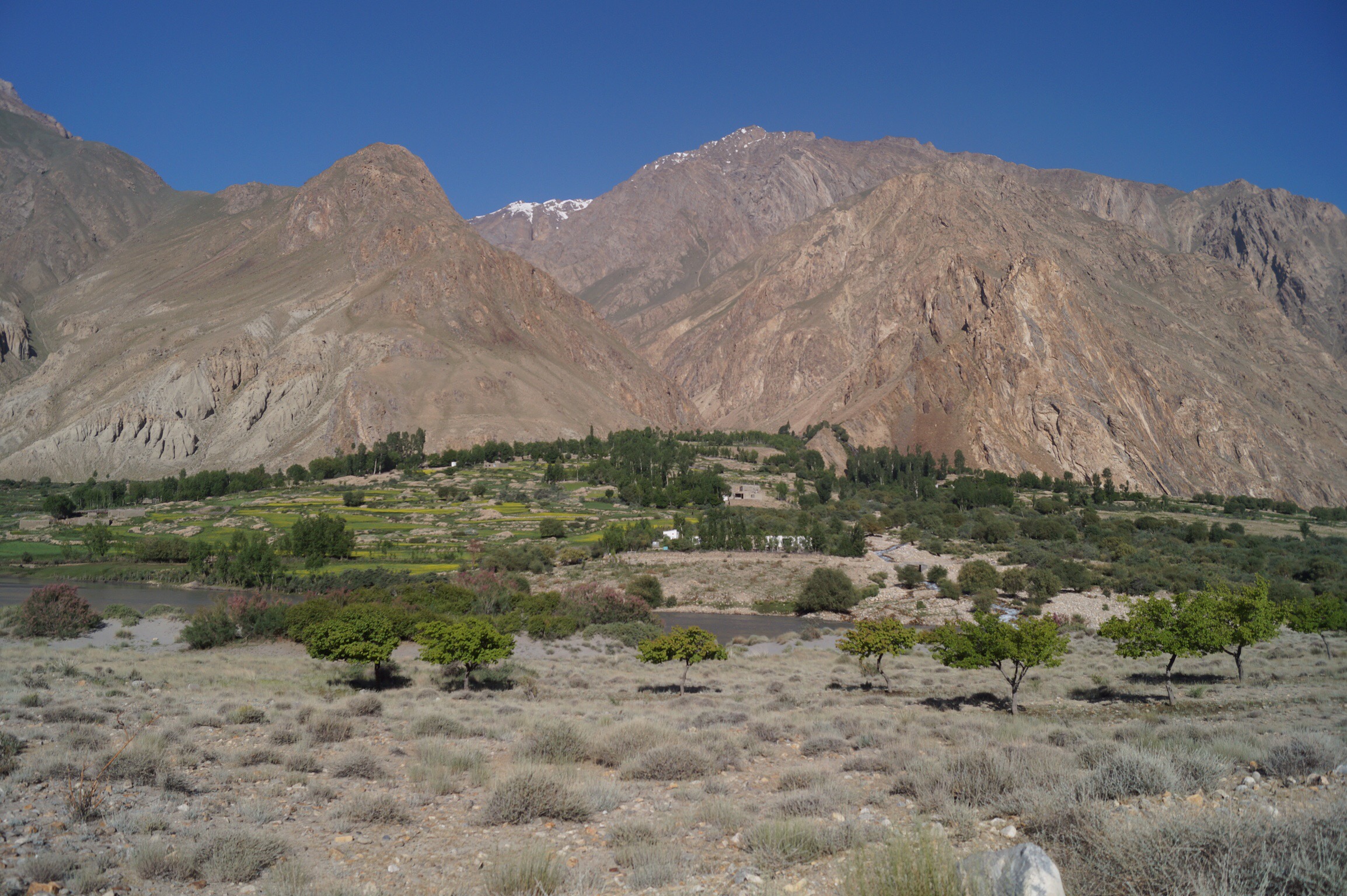
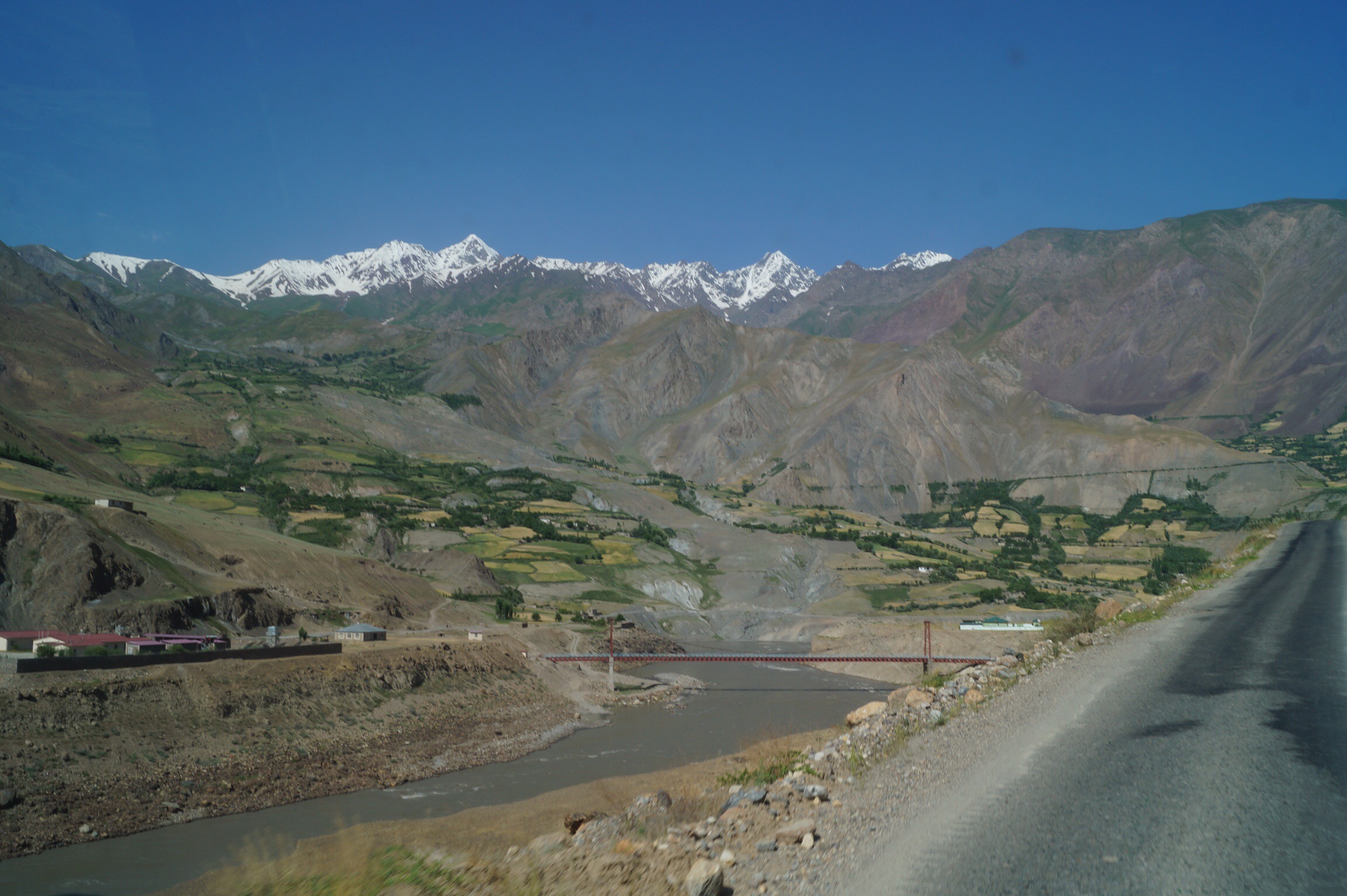
Where's the next bit of road!?!

The rest of the week was spent slowly, and very bumpily, making our way along the 640km of the Pamir Valley. To the left of us, the river gradually swelling from a grey gushing stream to a scary looking muddy brown torrent. As normal as it is for this time of year, as more meltwaters join from the mountains every kilometre. It must have been pretty high this year as the swirling waters crashed against the sides of the canyon, flooding the banks and we saw it had even washed away some of the road on the Afghan side.
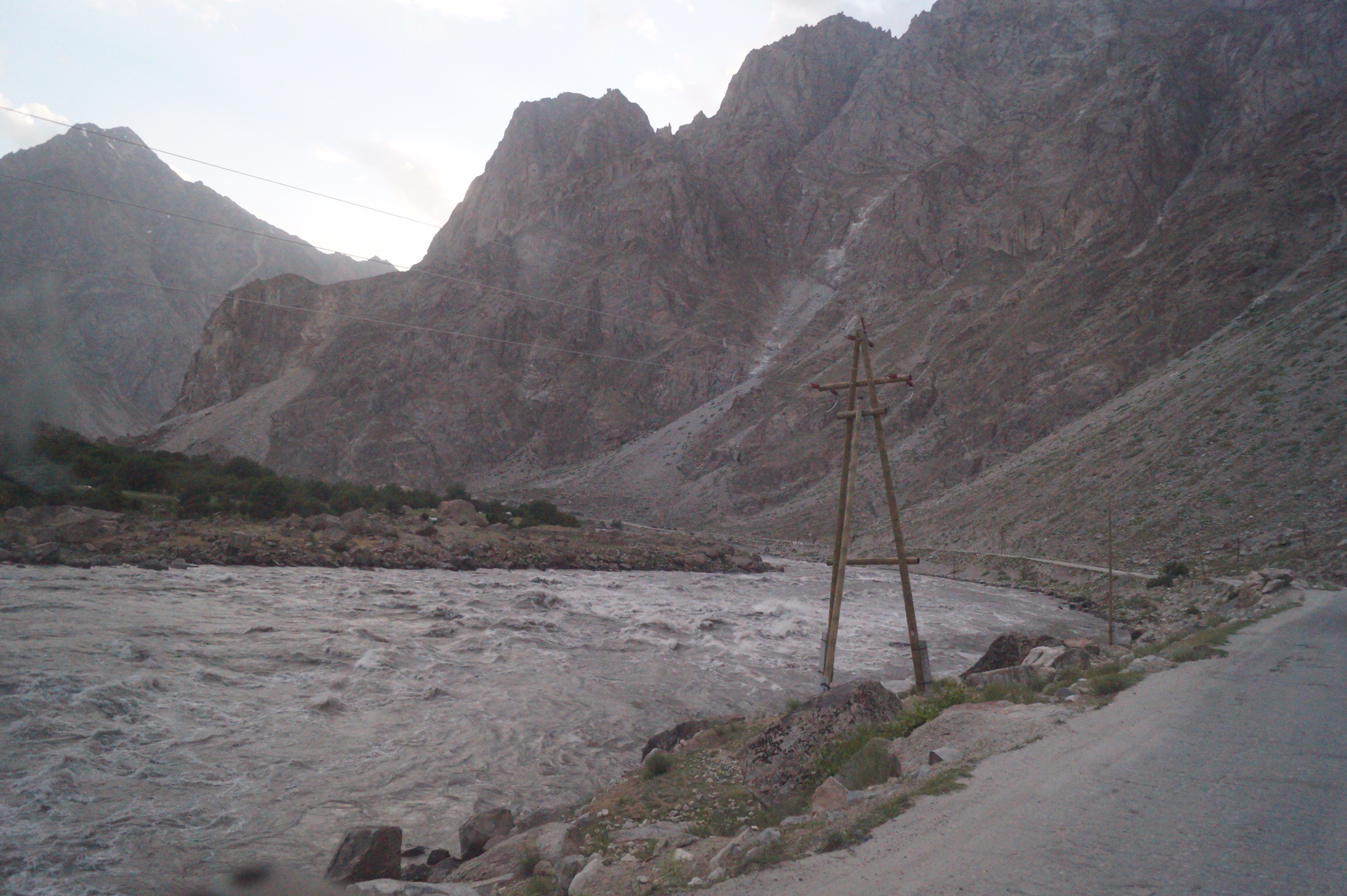
One of our favourite spots was in the widest part of the valley, where the river had spread out and slowed to a less alarming flow. We found a spot on the riverbank way off the road, surrounded by purple flowering bushes and a partially separated branch of the river that had warmed in the sun. Time for a family hair wash and a whole body dip for the bravest of us all (Lucy). Our hot water heater tank broke way back in Thailand and these last couple of months in the mountains have been painful at times, so we were thankful for the slightly warmer wash.
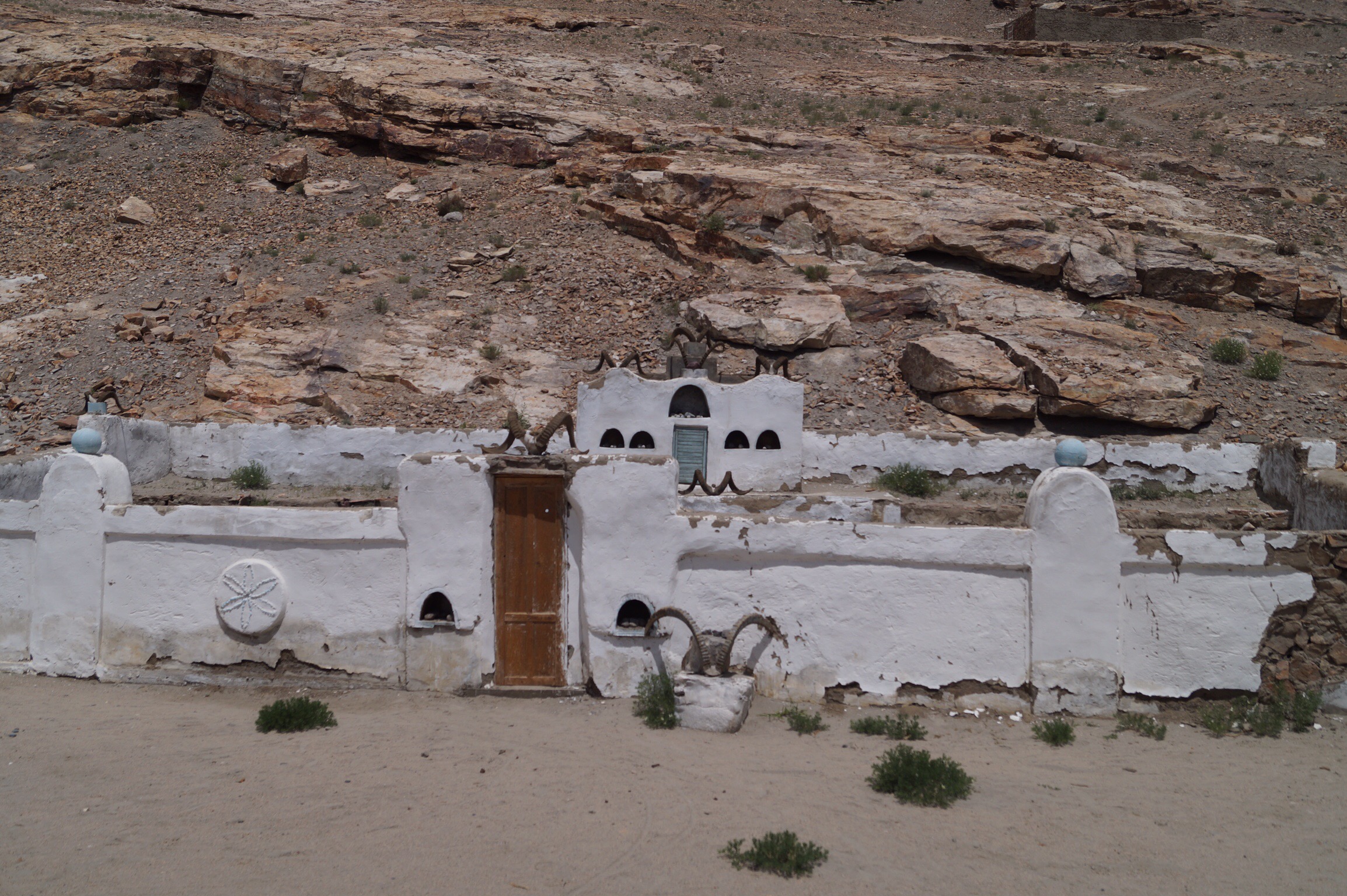
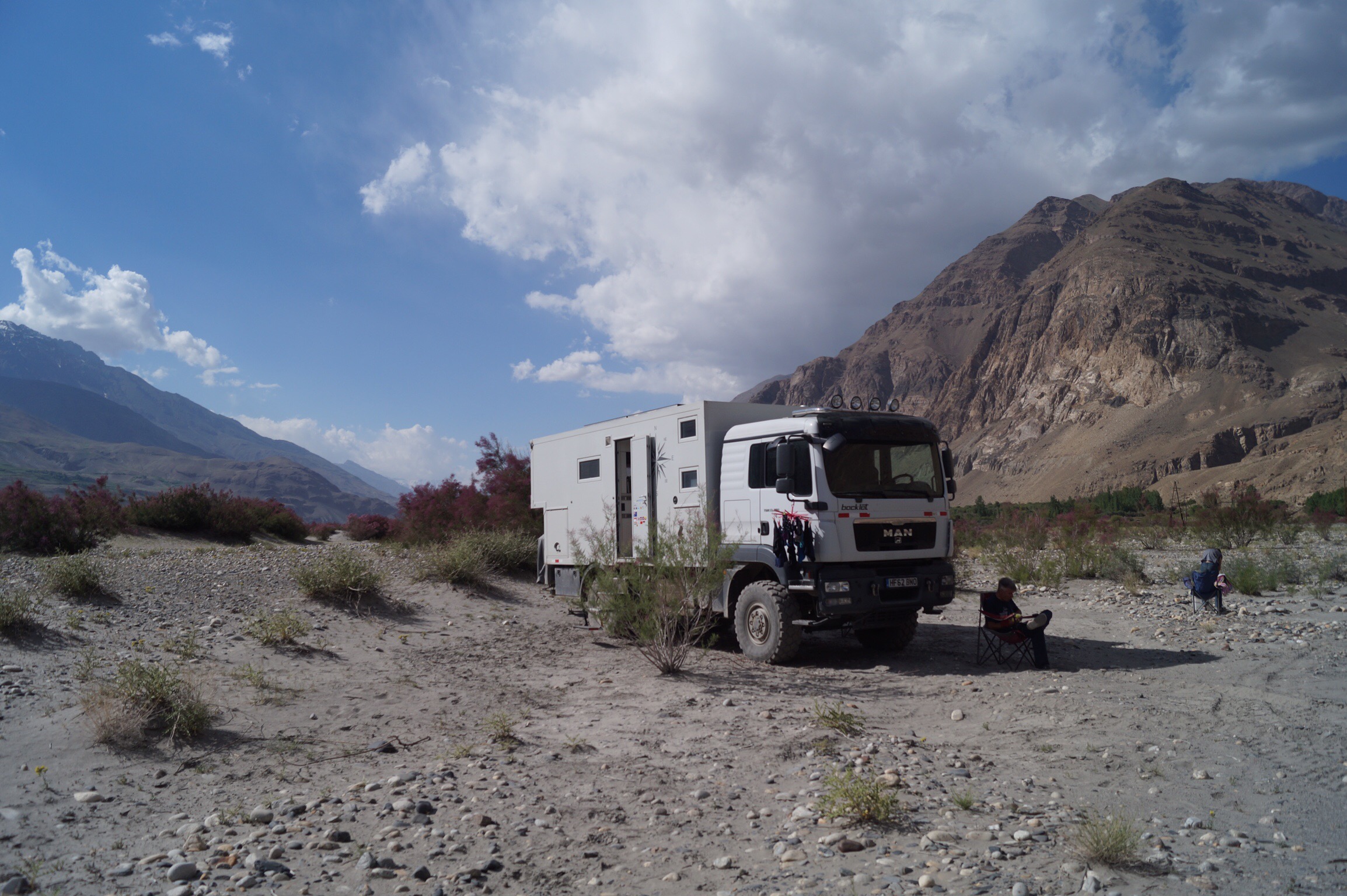
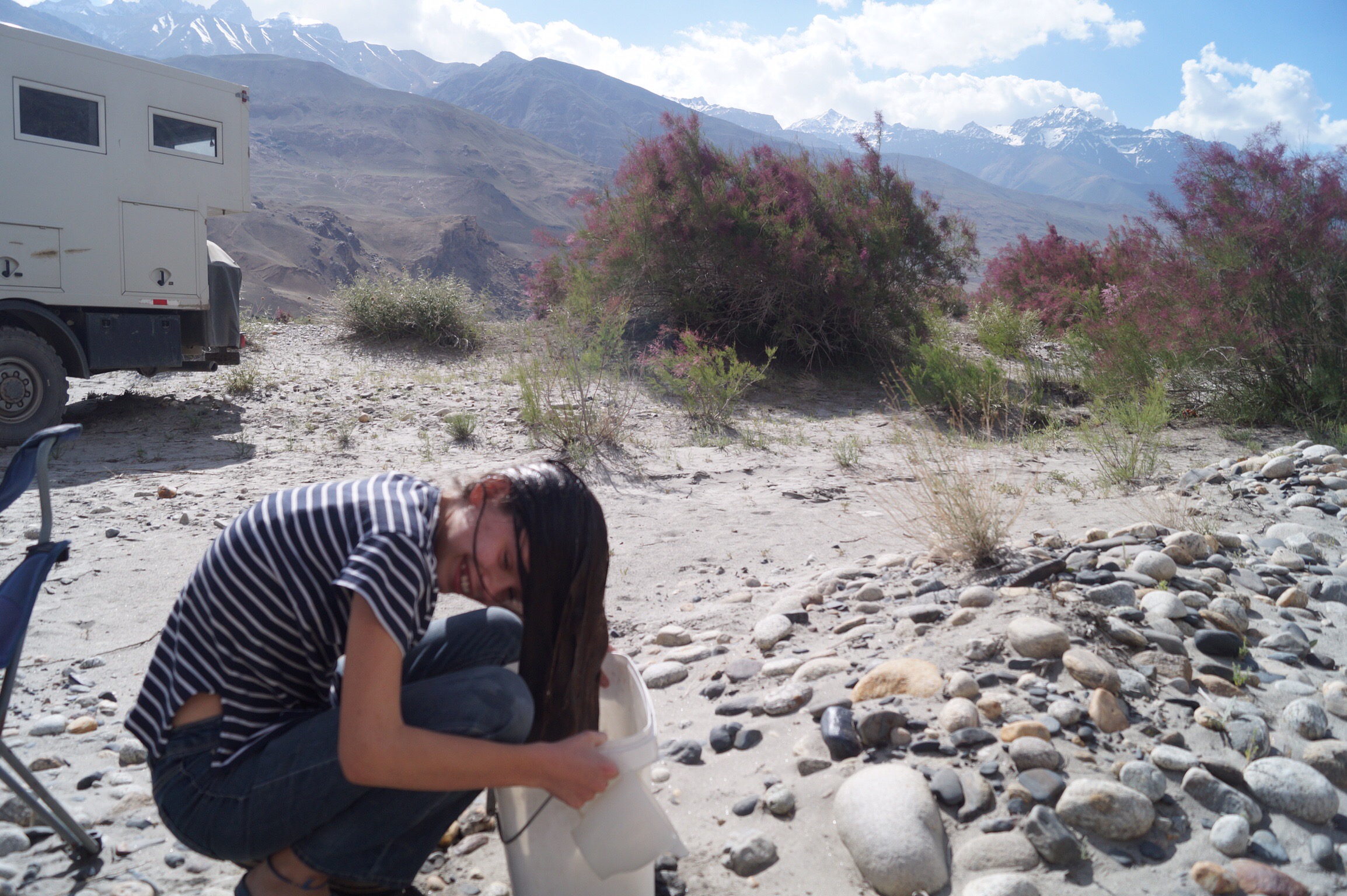
In Khorog, the pleasant main town of the Pamirs Steve went off to find a welder for our disc-brake covers, a reoccurring problem every 10,000 km. Asking some workmen demolishing a house, they took him to another building site and welded the 2 covers. They refused any payment at all, even money for cigarettes, with a "Welcome to Khorog. " The next day Steve replayed the karma by helping a couple of local guys who were subjecting their poor tiny Chevrolet Spark to hundreds of kilometres of roads that were challenging for a hardcore 4x4, with only a screwdriver for a repair kit. Unsurprisingly their steering rods had gone awry. On a road like that, I'm not sure they were going to make their final destination without another roadside stop, hopefully someone else nearby will have more than a screwdriver.


Driving up the narrow and steep Bartang Valley to the north, hoping to do a short trek, I lost my nerve and made Steve turn round when we were already 16 km in. The river took up the whole width of the valley, flooding any possible place where we might camp, and was lapping the edge of the low track. The fast flowing torrent wouldn't look out of place in a disaster movie, especially in such a steep-sided, narrow canyon. Only the 3 villages we passed through, tiny pockets of green in the brown bare valley, seemed high enough out of the waters. The villagers were working hard in the short summer, planting and nurturing their crops in every inch of green. However, they didn't seem at all perturbed by the amount of water, smiling and waving as we passed back through. I stuck with my overlanding mantra, "Always go with your instincts." Seeing the floods, we decided that the trek didn't look at all attractive. As it started with a valley crossing in a metal box suspended across the swollen river a bit like cable car, just big enough for 4 - definitely like a start of a disaster movie!
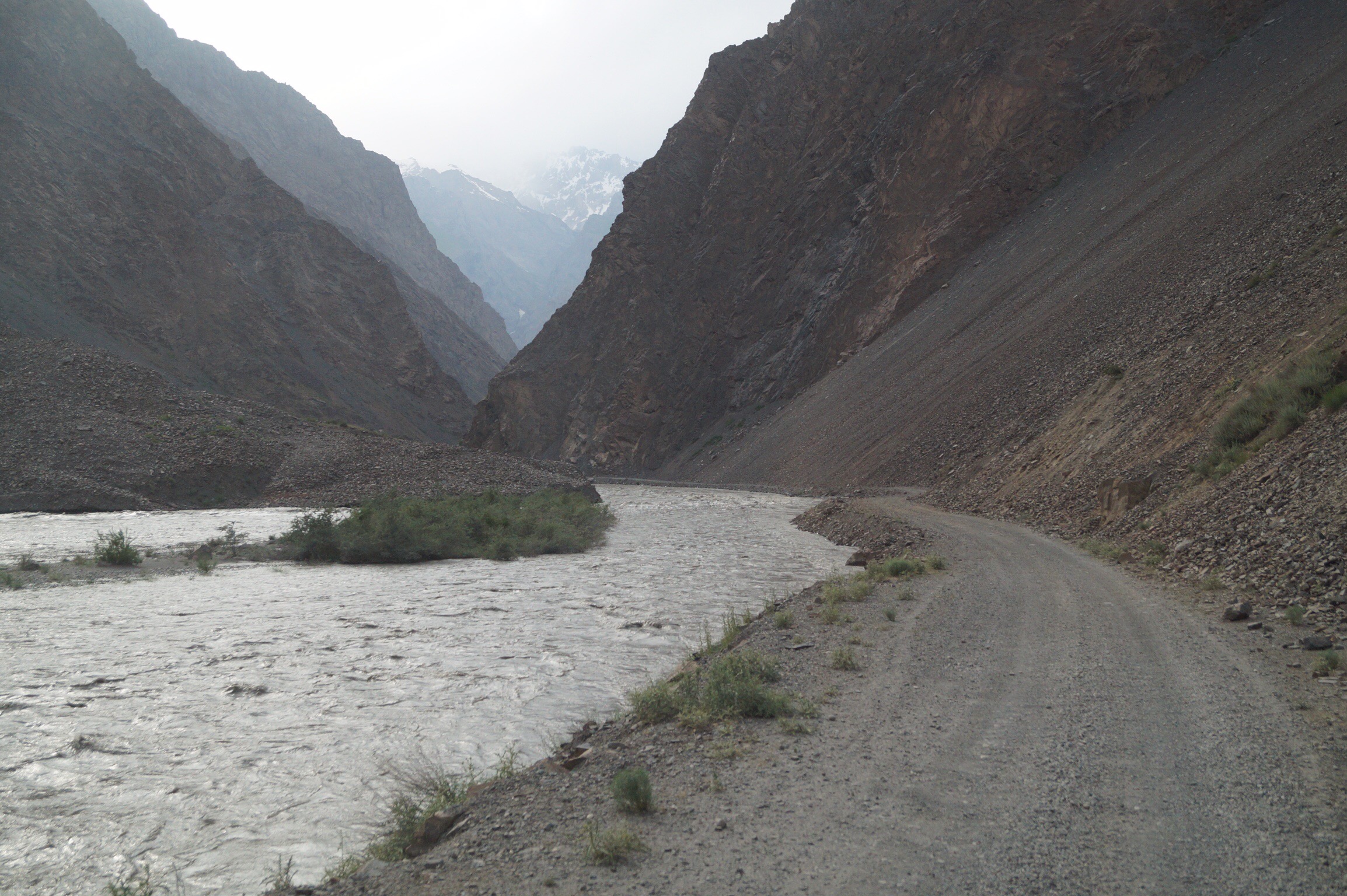
It was almost dark when we eventually found a spot off the road with no rock falls above and away from edge of the cliff dropping off into the river. In the end the only spot we could find was at an steep angle just a few metres off the road. We moved on early the next morning and drove for a couple of hours to find a flat spot for school, it's hard to concentrate on your sums when your pencil keeps on rolling off the table. The temperature was rising as we finished school and lunch and we were set for the afternoon of bumping along the next few kilometres, when Steve heard the tell tale "hiss" - a slow puncture. The flat meadow away from the dusty road, isn't a bad place to spend the afternoon getting all sweaty and dirty. It took a couple of hours to get back on the road. Thankfully a carload of friendly guys, happy to show off their masculinity, came along just at the right point. Helping us lift the 120kg tyre in its rack back onto position onto the back of the truck, a less than one minute job but the one thing the two of us can't do on our own.
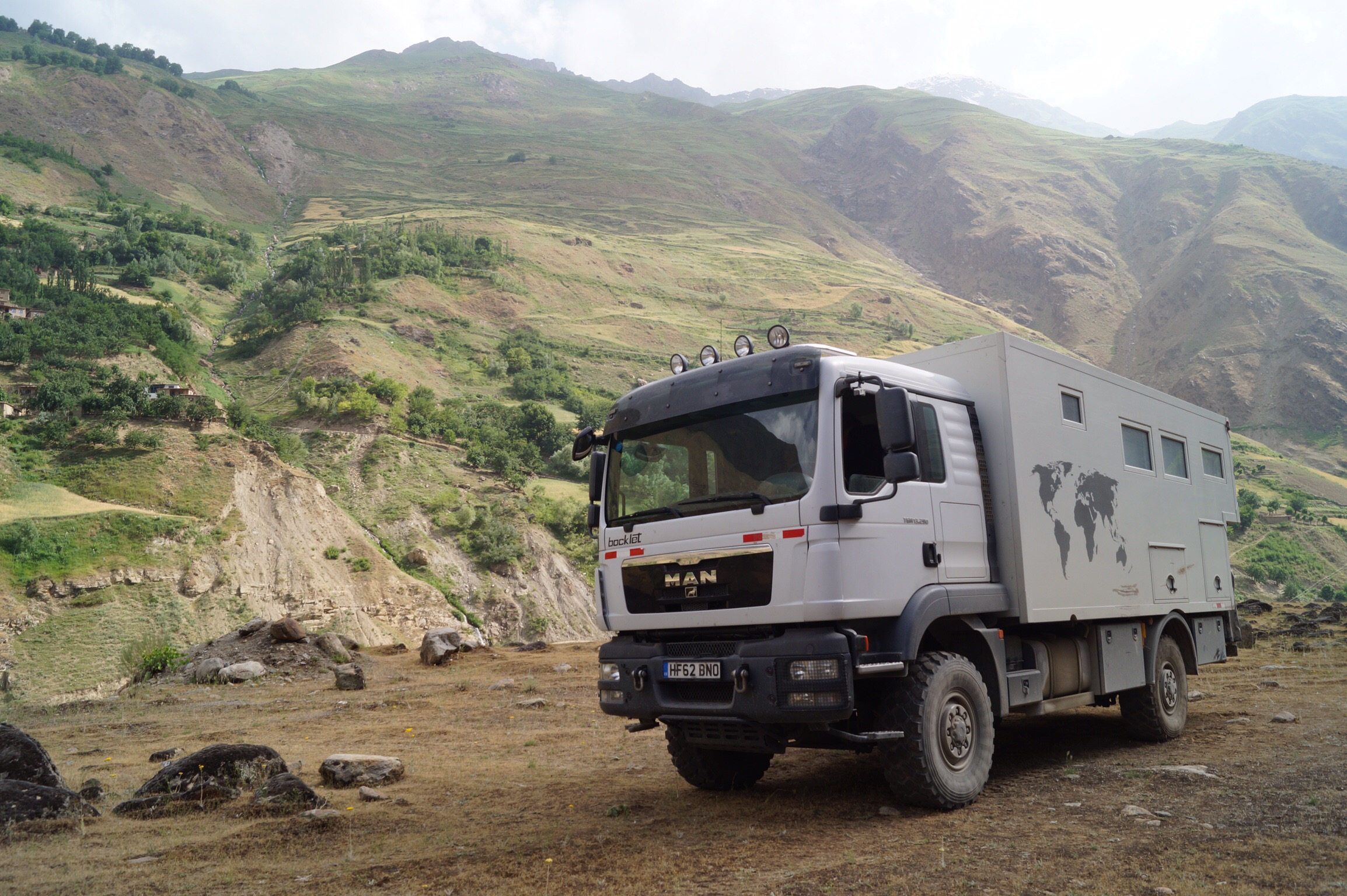
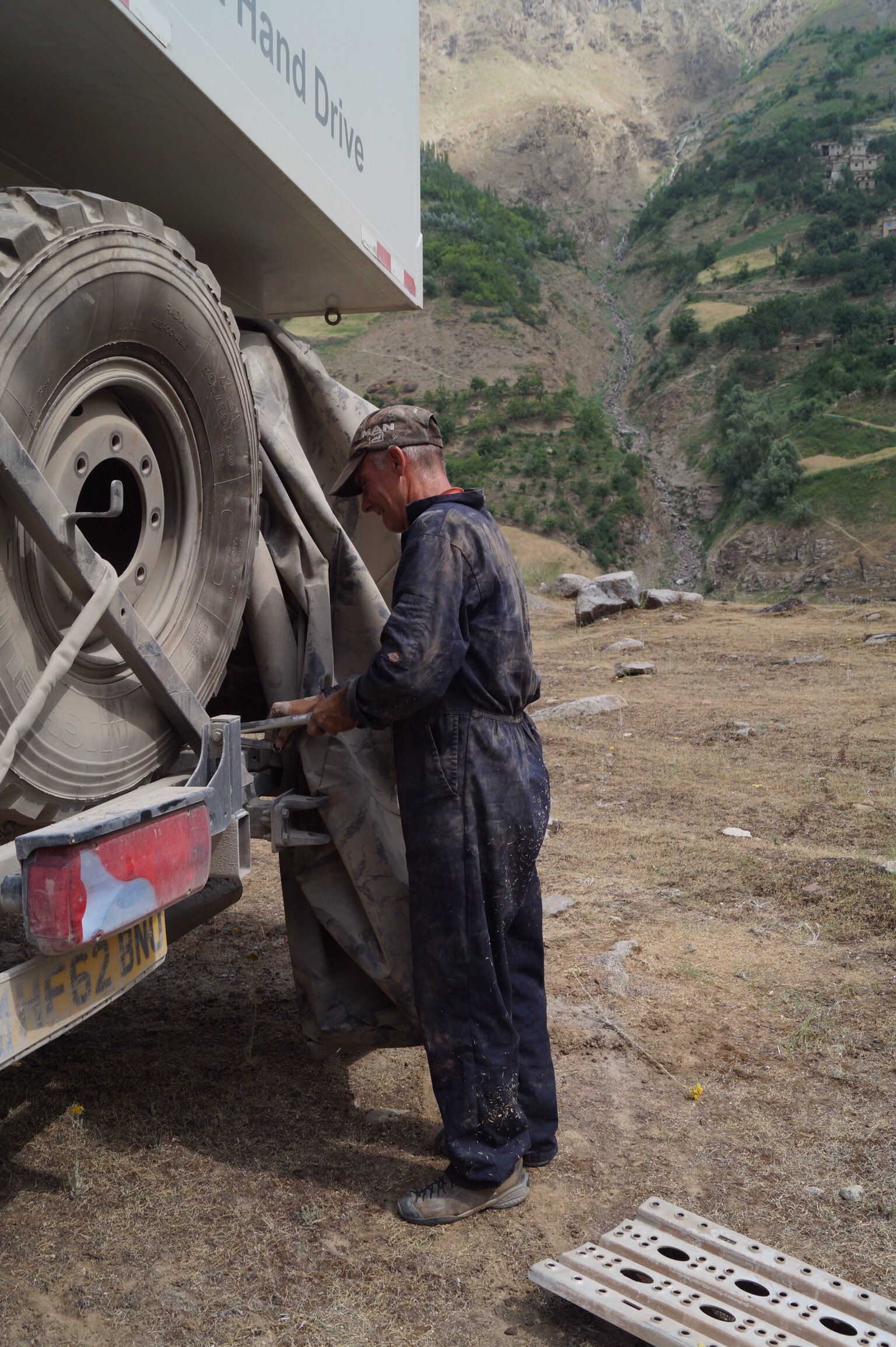
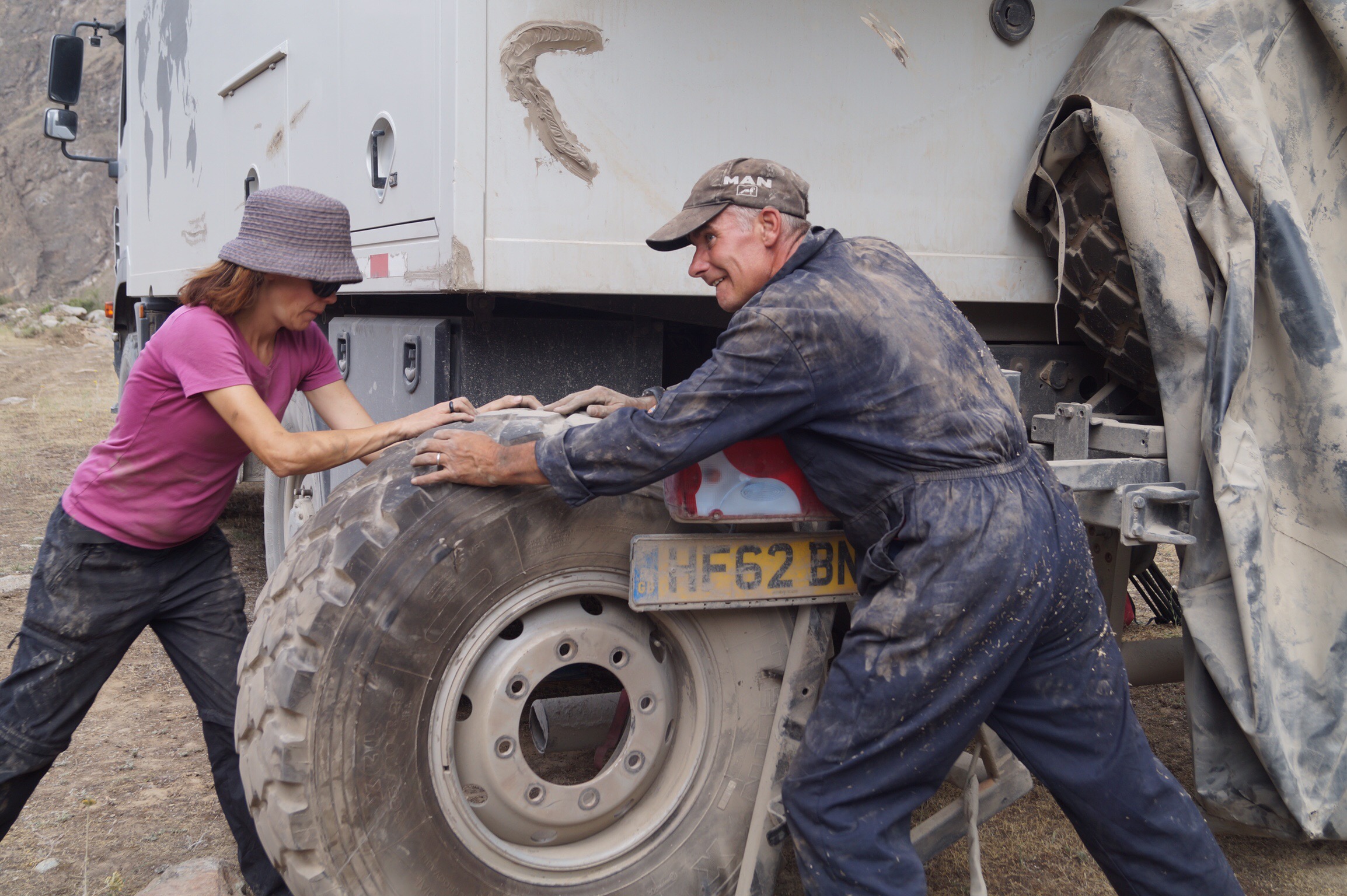
Both the Pamirs and the Wakan Corridor amazed us with their stark natural beauty and sense of remoteness. The constant dichotomy at looking up in awe at the mountains and down in horror at the road and the rushing river below us, was thrilling. We loved being out in the wilds; camping properly again; cooking outside; and the joy of the open road. But suddenly and almost unexpectedly it was over, after hundreds of bone jarring and shock absorber breaking kilometres, we hit Chinese laid smooth tar 50 km before the last pass. We cruised our way through villages, rather than squeezing our way through avenues of mulberry trees, and easily passed the double-length China bound articulated lorries (I kid you not!) we had been praying not to meet on the tightest corners. The river then veered off to the left at the bottom of the pass, as we headed up and onwards to the hot dry hills of central Tajikistan. Pamirs - we will miss you.
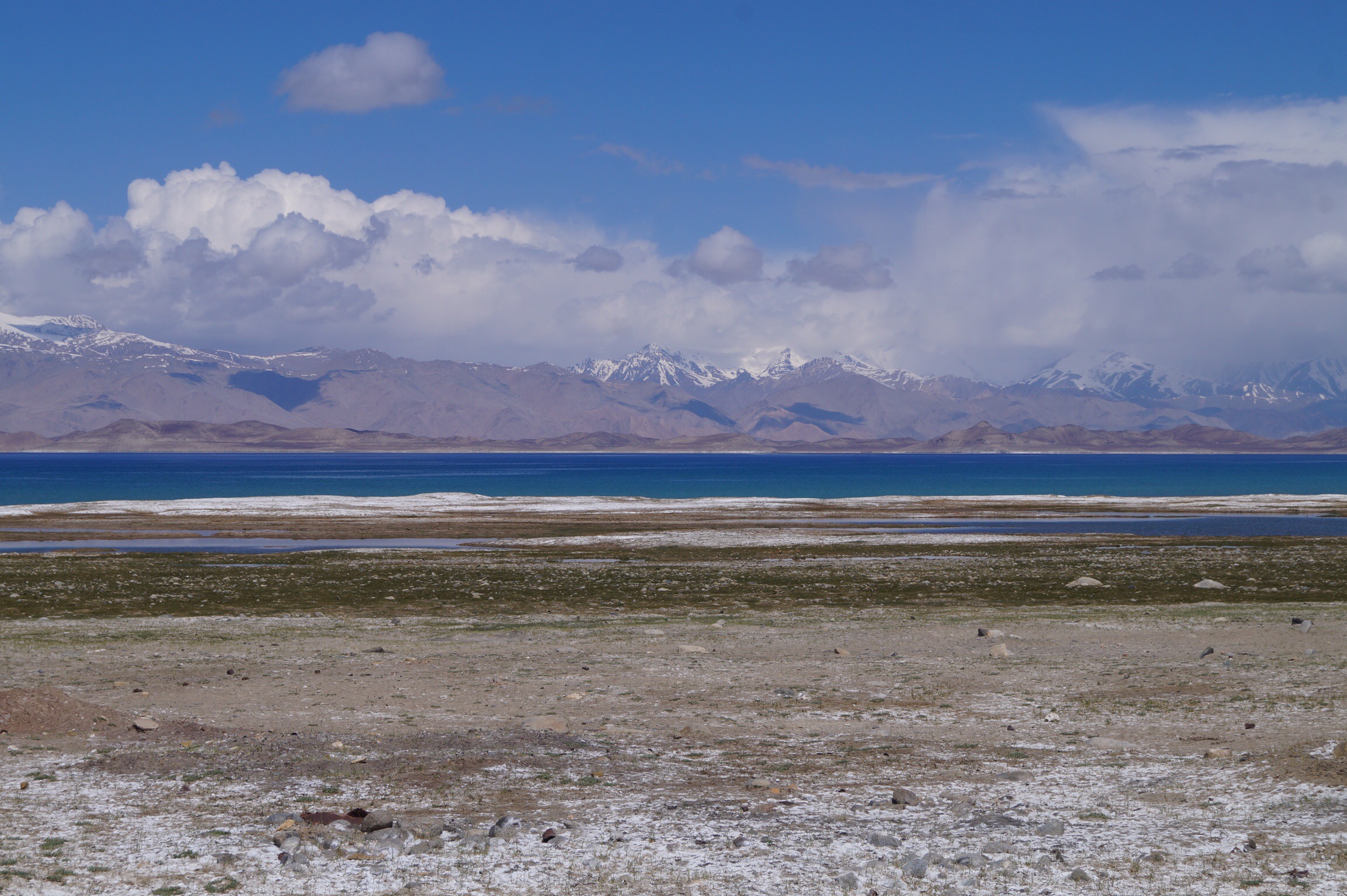
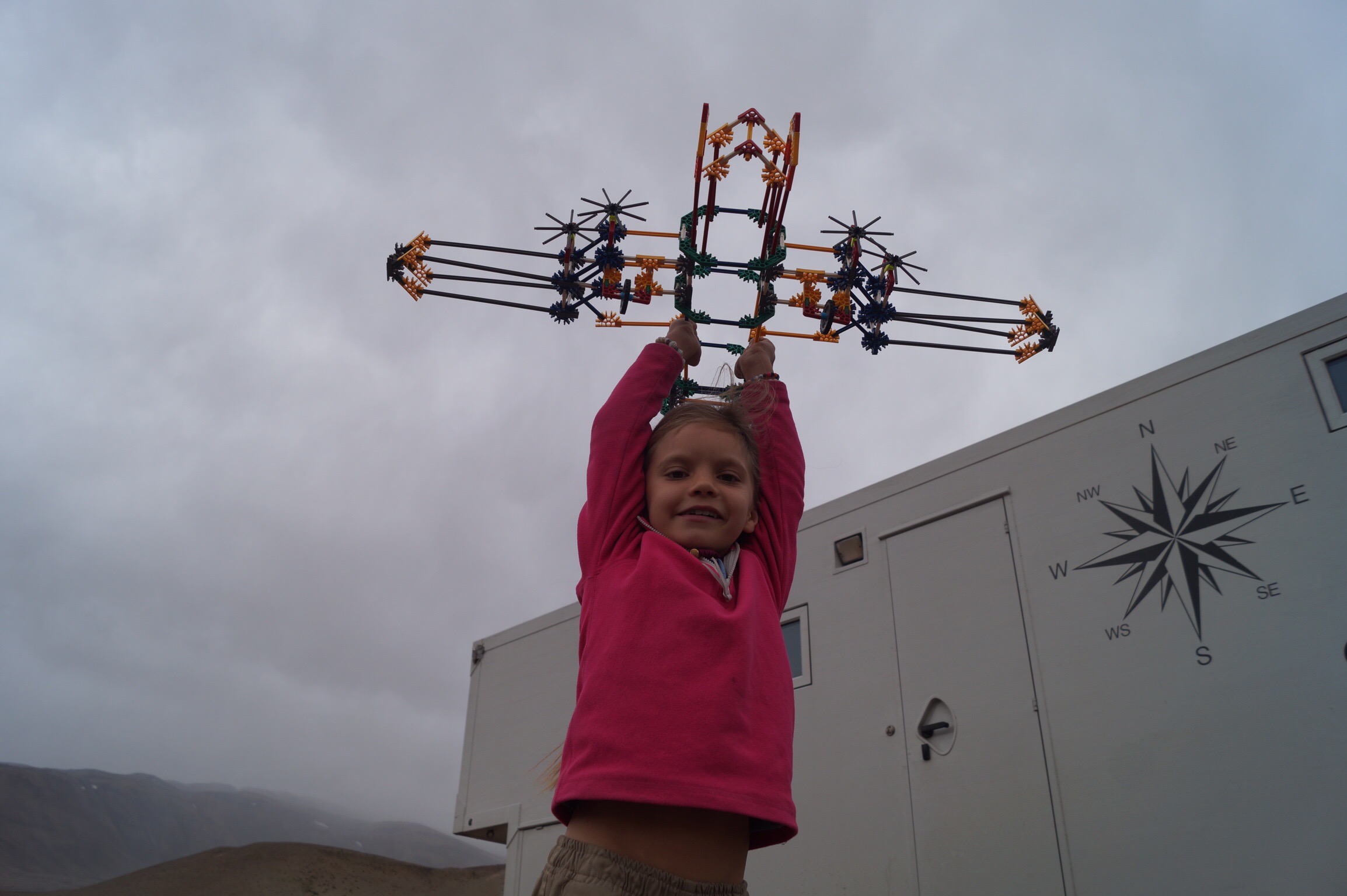
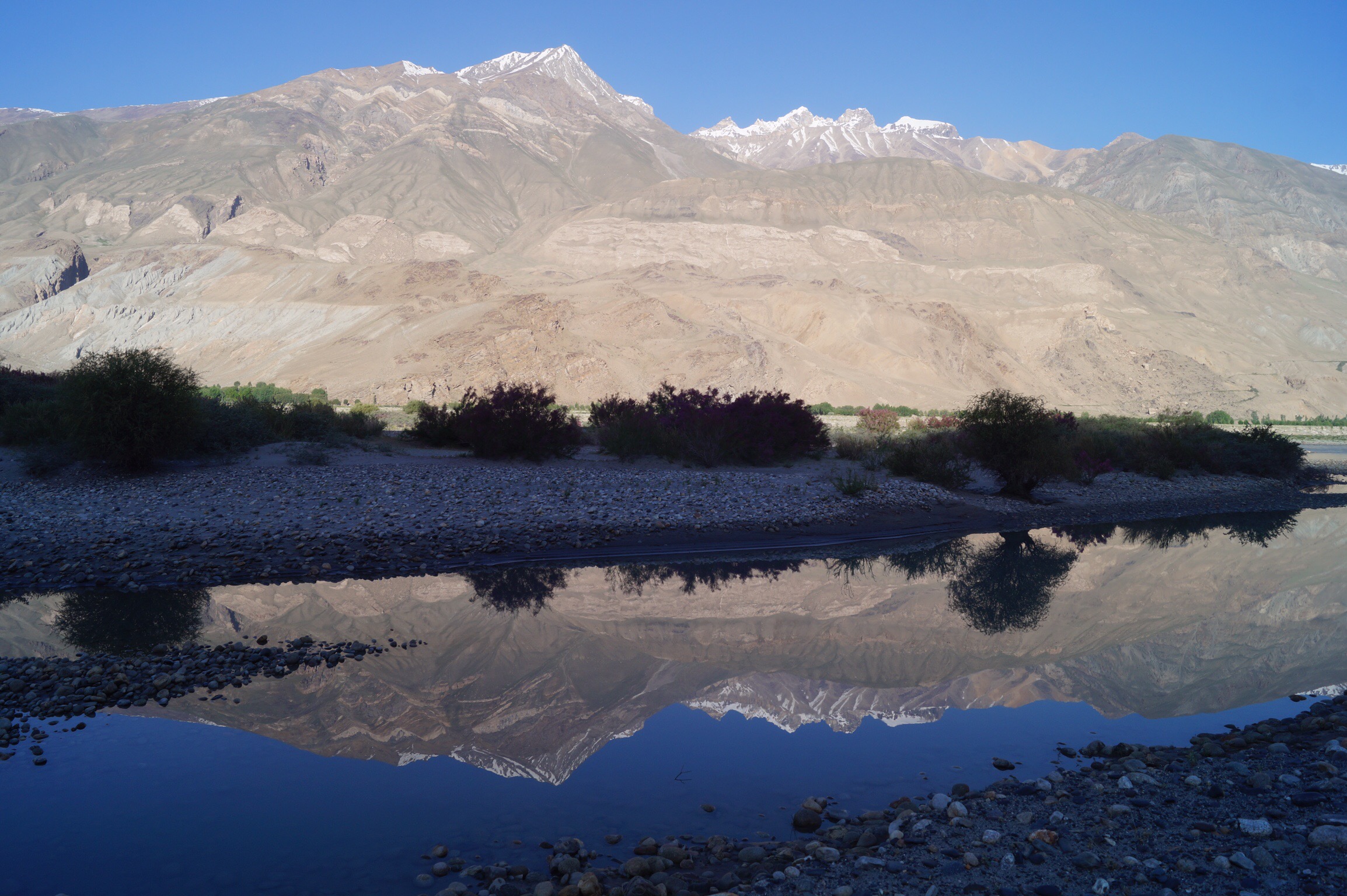
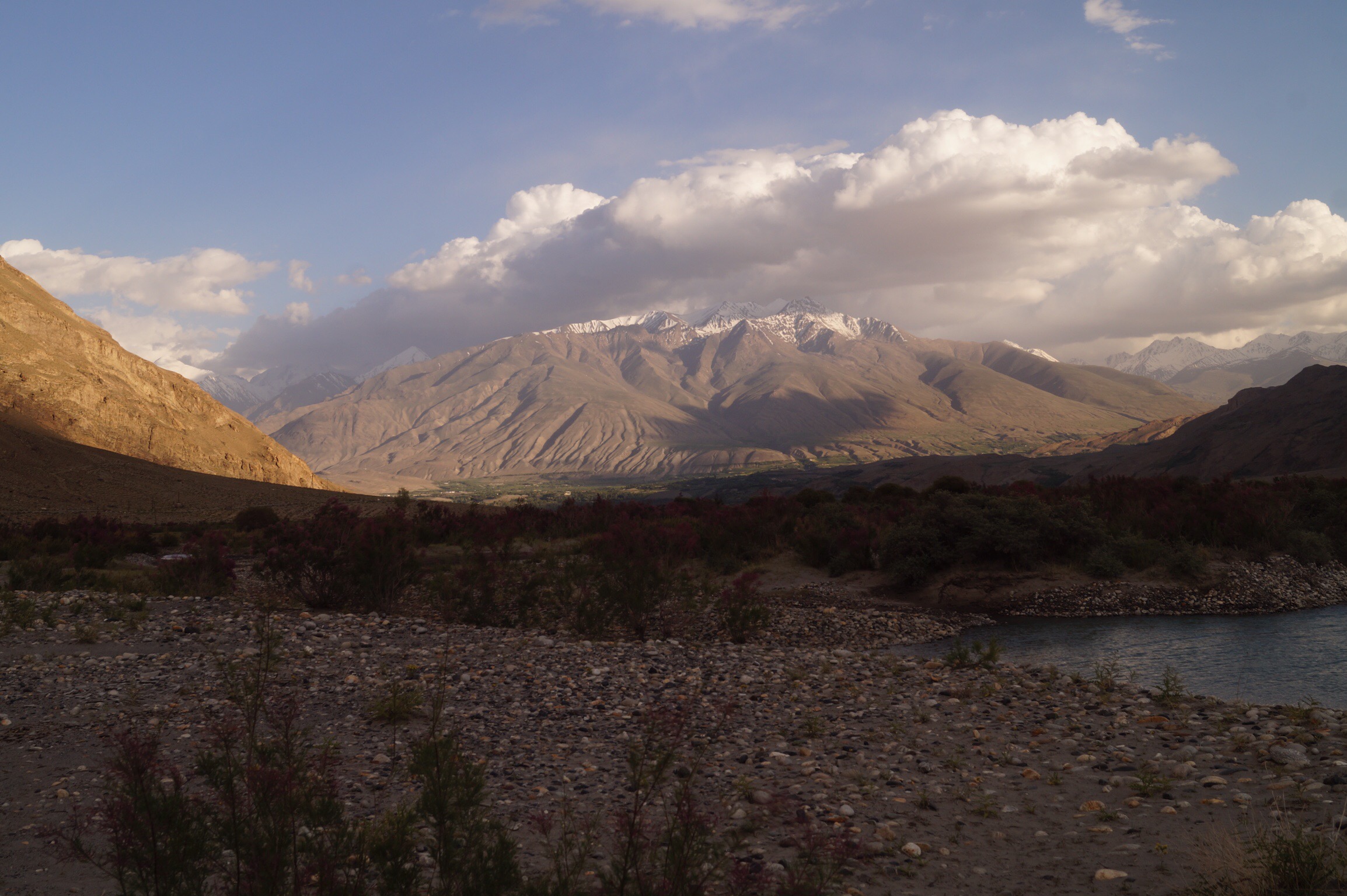
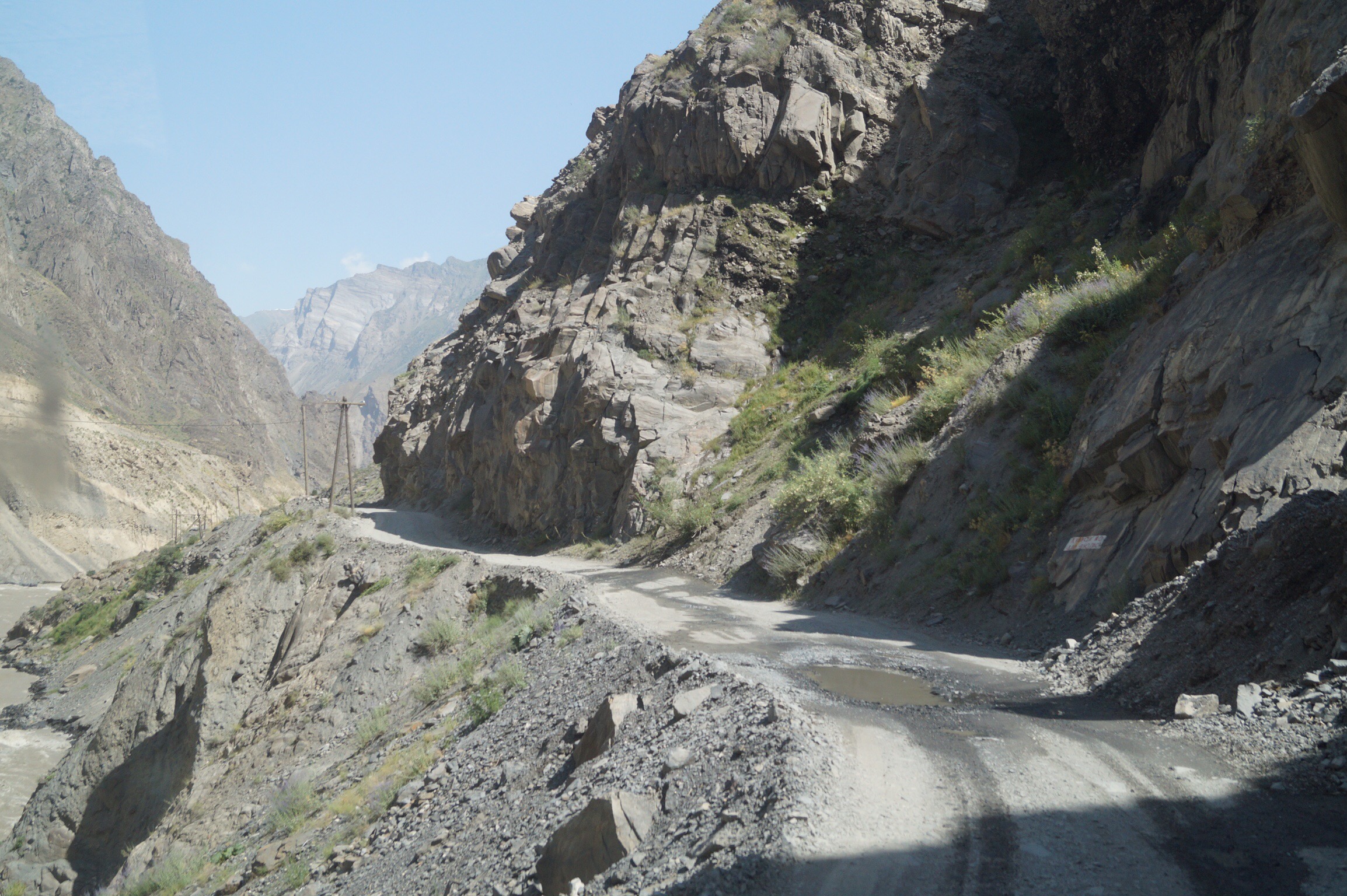
 Lucy
We entered the 'Stans with high hopes to see beautiful mosques, rugs, architecture and eat interesting foods. We had been studying the Silk Road so we knew about the history. I was hoping to see some camels laden with goods trekking across the desert. I would have loved to see it in its former glory with merchants bargaining in the markets and buying jade, silk, turquoise and carpets. It's called the Silk Road because that was the thing mostly traded with China. We saw some caravanasis where they stayed at night and yurts the official houses of the travelling nomads.
Lucy
We entered the 'Stans with high hopes to see beautiful mosques, rugs, architecture and eat interesting foods. We had been studying the Silk Road so we knew about the history. I was hoping to see some camels laden with goods trekking across the desert. I would have loved to see it in its former glory with merchants bargaining in the markets and buying jade, silk, turquoise and carpets. It's called the Silk Road because that was the thing mostly traded with China. We saw some caravanasis where they stayed at night and yurts the official houses of the travelling nomads.
 Mummy bought some blue tiles, just like they had on the buildings. They were very pretty, I liked bargaining like a real merchant.We went to a tea shop where they served nuts, raisins, sweets and tea. I loved the solid crystals of sugar they crunched with a sweet delicious flavour in my mouth.
Mummy bought some blue tiles, just like they had on the buildings. They were very pretty, I liked bargaining like a real merchant.We went to a tea shop where they served nuts, raisins, sweets and tea. I loved the solid crystals of sugar they crunched with a sweet delicious flavour in my mouth.
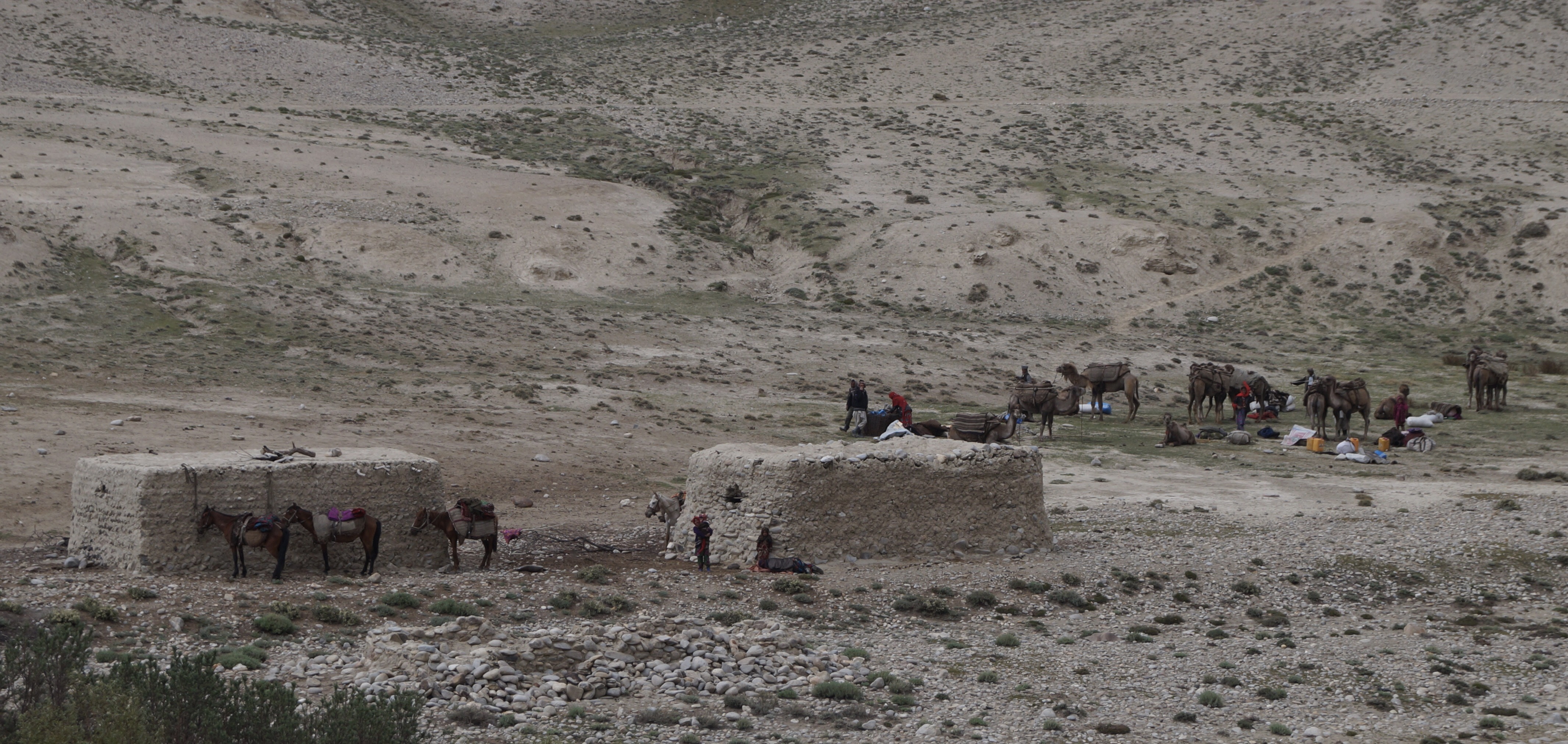 To leave Central Asia we had to cross the sea, I was sad to leave but I always knew we would have new adventures in the next place.
Alisha
From mountains in Kyrgyzstan and Tajikistan to mausoleums in Uzbekistan and deserts in Kazakstan. Central Asia is a riot of culture and traditions that are mixed into their modern lives you see herders with cell phones, yurts with satellite dishes and ancient mosques with security cameras.
To leave Central Asia we had to cross the sea, I was sad to leave but I always knew we would have new adventures in the next place.
Alisha
From mountains in Kyrgyzstan and Tajikistan to mausoleums in Uzbekistan and deserts in Kazakstan. Central Asia is a riot of culture and traditions that are mixed into their modern lives you see herders with cell phones, yurts with satellite dishes and ancient mosques with security cameras.
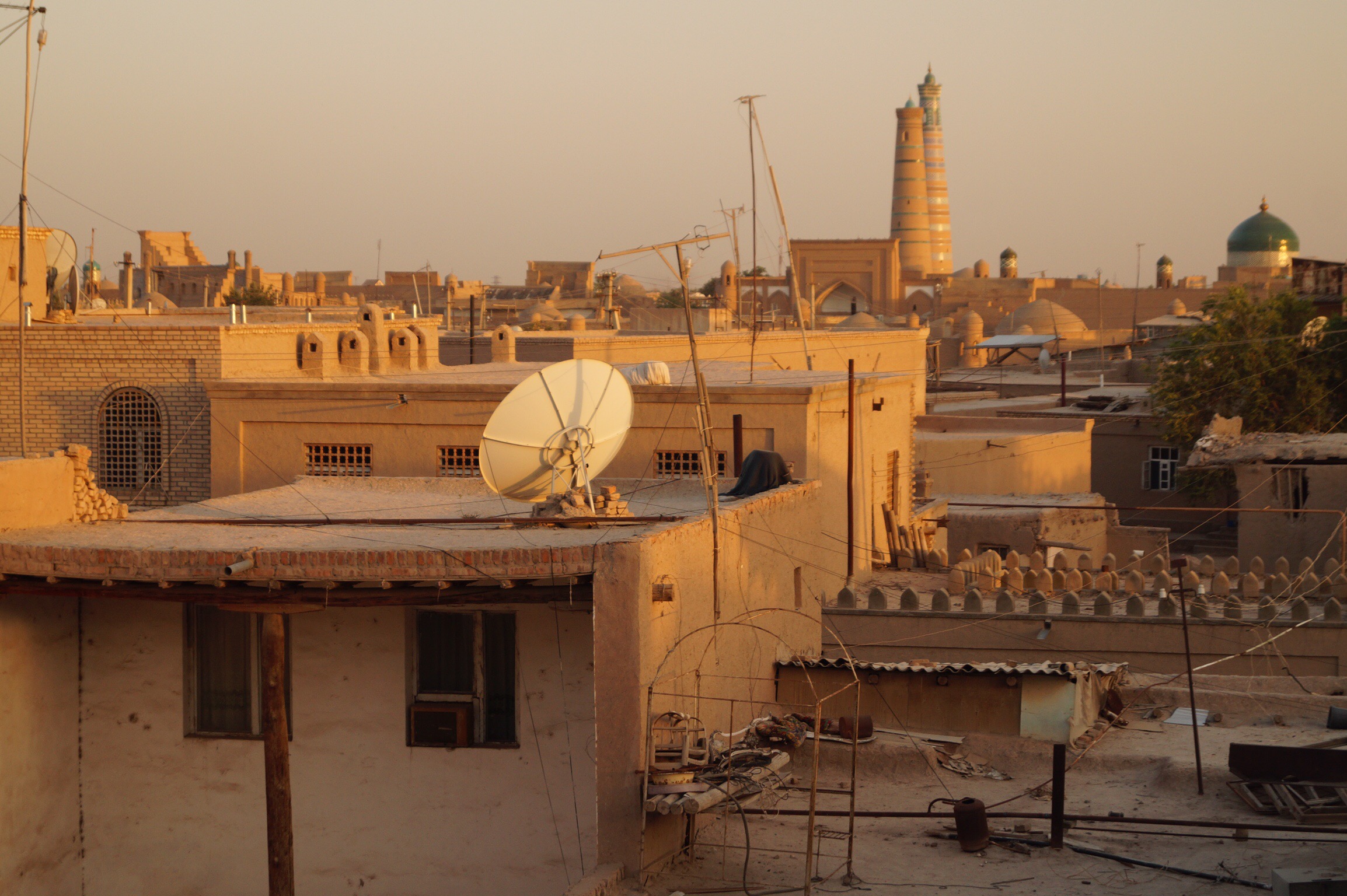 I enjoyed Kyrgyzstan because it was a nice cool place with mountains and difficult roads and just the sort of place strange people like us like to hang out. Tajikistan was much the same, it was funny being a stone's throw from Afghanistan (well a daddy's stone throw, I didn't quite make it). If I had to think of one word to describe Uzbekistan it would be HOT in the truck once it hit 54 degrees. If you want to feel 54 degrees then go into the hottest sauna ever and times the heat by a 100. If you haven't got a sauna then book a flight to Uzbekistan. Kazakstan wasn't so hot which was a relief but it was boring, landscape-wise, at least the bit we traveled through if you show me a picture of a bit we traveled through and a bit we didn't I wouldn't of been able to tell the difference.
I enjoyed Kyrgyzstan because it was a nice cool place with mountains and difficult roads and just the sort of place strange people like us like to hang out. Tajikistan was much the same, it was funny being a stone's throw from Afghanistan (well a daddy's stone throw, I didn't quite make it). If I had to think of one word to describe Uzbekistan it would be HOT in the truck once it hit 54 degrees. If you want to feel 54 degrees then go into the hottest sauna ever and times the heat by a 100. If you haven't got a sauna then book a flight to Uzbekistan. Kazakstan wasn't so hot which was a relief but it was boring, landscape-wise, at least the bit we traveled through if you show me a picture of a bit we traveled through and a bit we didn't I wouldn't of been able to tell the difference.
 In Uzbekistan I saw a few too many mosques, they where all blue-tiled and had a dome if you seen ten you've seen them all there is absolutely no need to see five million more.
Gilly
Melons are everywhere in Central Asia. Delicious and refreshing and piled up high on every street corner. Flat light bread still warm from the tandoor oven and mutton kebabs, served with salads made for delicious meals, with melon, of course, for desert. The 'Stans' shared Russian heritage made Steve and I nostalgic for our time in Moscow. While I will never enjoy dill liberally sprinkled on every single meal, we did search out some of our old favourite foods. Steve and Alisha embarked on a multinational search for authentic pelmeni (steamed meat dumplings), a mutual passion after sharing many a bowlful when Alisha was little.
In Uzbekistan I saw a few too many mosques, they where all blue-tiled and had a dome if you seen ten you've seen them all there is absolutely no need to see five million more.
Gilly
Melons are everywhere in Central Asia. Delicious and refreshing and piled up high on every street corner. Flat light bread still warm from the tandoor oven and mutton kebabs, served with salads made for delicious meals, with melon, of course, for desert. The 'Stans' shared Russian heritage made Steve and I nostalgic for our time in Moscow. While I will never enjoy dill liberally sprinkled on every single meal, we did search out some of our old favourite foods. Steve and Alisha embarked on a multinational search for authentic pelmeni (steamed meat dumplings), a mutual passion after sharing many a bowlful when Alisha was little.
 Although there is a lot to choose from, I thing for me the highlight was the Pamirs and the Wakhan Valley. Dramatic scenery; snow capped peaks; uninhabited wilderness; right next to a fascinating rogue state (which sadly I am never likely to visit); swollen rivers of snowmelt; and challenging roads made it an unforgettable part of the adventure.
Silk Road cities of Uzbekistan: Samarkand; Bukhara and Khiva all enthralled us with their historical significance and amazing architecture. Whilst I couldn't get enough of turquoise domes and blue tiled arched entrance ways, I could have done without the 45°C heatwave we had whilst we were there.
An unexpected perk of the need to register in a hotel for most of your nights in Uzbekistan (something that was never checked when we left) was meeting other travellers. Since trekking in Nepal, we have met very few other travellers and no other overlanders. Central Asia in the summer is quite popular with independent travellers, motorcyclists and especially long distance cyclists. It was also great to hangout with another overlanding family, our first since Africa, in Samarkand. It was also fun to pair up across the desert with Cate and Michael. At least with the catalogue of minor mechanical problems both the truck and Cate's bike had were easily fixed with many hands.
Although there is a lot to choose from, I thing for me the highlight was the Pamirs and the Wakhan Valley. Dramatic scenery; snow capped peaks; uninhabited wilderness; right next to a fascinating rogue state (which sadly I am never likely to visit); swollen rivers of snowmelt; and challenging roads made it an unforgettable part of the adventure.
Silk Road cities of Uzbekistan: Samarkand; Bukhara and Khiva all enthralled us with their historical significance and amazing architecture. Whilst I couldn't get enough of turquoise domes and blue tiled arched entrance ways, I could have done without the 45°C heatwave we had whilst we were there.
An unexpected perk of the need to register in a hotel for most of your nights in Uzbekistan (something that was never checked when we left) was meeting other travellers. Since trekking in Nepal, we have met very few other travellers and no other overlanders. Central Asia in the summer is quite popular with independent travellers, motorcyclists and especially long distance cyclists. It was also great to hangout with another overlanding family, our first since Africa, in Samarkand. It was also fun to pair up across the desert with Cate and Michael. At least with the catalogue of minor mechanical problems both the truck and Cate's bike had were easily fixed with many hands.
 Steve
There was a lot of diversity in Central Asia; from the mountains to the desert, from the cold to the heat, from the unusual to the familiar. After living in Russia many things seemed comfortingly familiar and yet there were also some striking differences. The people were warm and friendly and yet we managed to enjoy lots of time in solitude in beautiful settings.
Steve
There was a lot of diversity in Central Asia; from the mountains to the desert, from the cold to the heat, from the unusual to the familiar. After living in Russia many things seemed comfortingly familiar and yet there were also some striking differences. The people were warm and friendly and yet we managed to enjoy lots of time in solitude in beautiful settings.
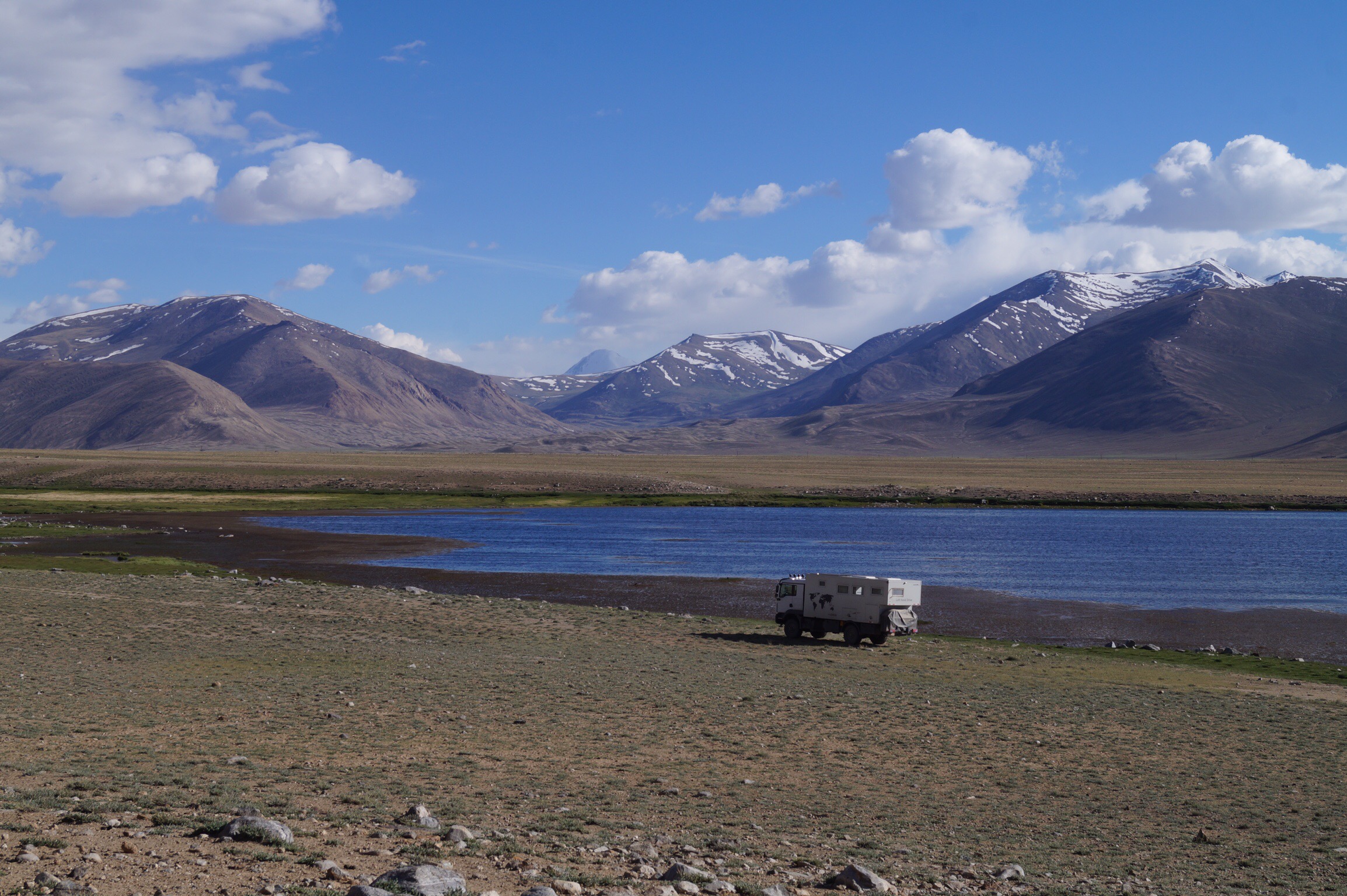 Kyrgyzstan was so green after the starkness of Xinjiang in China. Everywhere we went there was green meadows with running rivers and often the nomads with their yurts and horses camped for the summer. Tajikistan was more stark and rugged but the Pamir Highway and Wakhan corridor were barrenly beautiful with a raging river and pockets of green between it and Afghanistan. Uzbekistan was all about the ancient Silk Road cities. Whilst these have now been spruced up for tourism and at times felt a little soulless there is no denying the eye catching timeless beauty of the monuments. Even in the baking heat we just had to go out and see them again and again.
Kyrgyzstan was so green after the starkness of Xinjiang in China. Everywhere we went there was green meadows with running rivers and often the nomads with their yurts and horses camped for the summer. Tajikistan was more stark and rugged but the Pamir Highway and Wakhan corridor were barrenly beautiful with a raging river and pockets of green between it and Afghanistan. Uzbekistan was all about the ancient Silk Road cities. Whilst these have now been spruced up for tourism and at times felt a little soulless there is no denying the eye catching timeless beauty of the monuments. Even in the baking heat we just had to go out and see them again and again.
 We did not see a lot of Kazakhstan, mainly desert, but got to to camp there with new friends which was wonderful and saw some amazing sunsets. It was slightly surreal arriving at the Caspian Sea, an oil town and beach resort all rolled into one but one which allowed us a welcome break before the ferry crossing across the Caspian Sea.
Central Asia is a beautiful area of the world rich in diversity. We have met many more overlanders and long term travellers here than in other parts of Asia but it is still largely untouched by mass tourism and you really can get away from it all into areas of natural beauty.
We did not see a lot of Kazakhstan, mainly desert, but got to to camp there with new friends which was wonderful and saw some amazing sunsets. It was slightly surreal arriving at the Caspian Sea, an oil town and beach resort all rolled into one but one which allowed us a welcome break before the ferry crossing across the Caspian Sea.
Central Asia is a beautiful area of the world rich in diversity. We have met many more overlanders and long term travellers here than in other parts of Asia but it is still largely untouched by mass tourism and you really can get away from it all into areas of natural beauty. 
